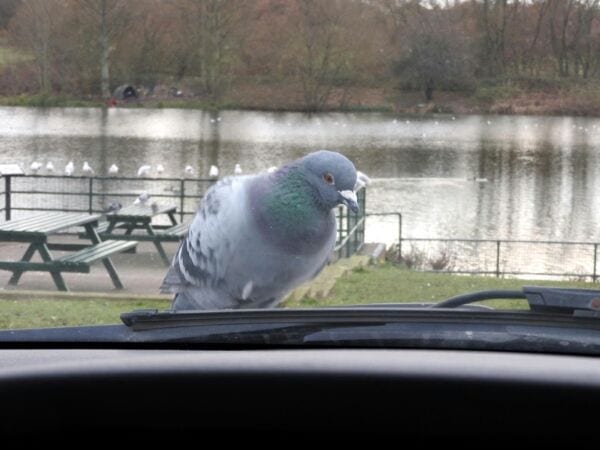
by Pigeon Patrol | Oct 26, 2020 | Animal Deterrent Products, Bird Deterrent Products, Pigeon Control, Pigeon Droppings, Pigeon Spikes
Pigeon Poop
So, How Long Before The Pigeon Poop Damages Your Belongings? High rated auto detailers say waiting too long to remove bird droppings and bugs from your car can lead to serious damage to the car’s paint job.
Imagine pulling out of the car wash — feeling good that you finally washed the winter salt and grime away — and: “Splat.” A bird poops on your car.
That momentary clean car feeling suddenly turns sour. If your car is a lightning rod for bird byproducts, try not to let it get you down in the, well, dumps. Highly rated auto detailers say it’s important to take a proactive approach and quickly wash away the poop and other harmful objects such as bugs and tree sap.
Damage Your Car Paint
Aside from the fact bird poop is gross to look at — especially a car covered in it — it can be extremely damaging to your car’s paint job. If left untreated, bird poop and bugs can penetrate your car’s clear coat protective layer.
“Bird poop and bugs have acid and can burn through the clear coat in as little as 48 hours,” says paint experts “Waiting too long can burn the clear coat and paint surface all the way to the metal. It increases when it’s hot outside [because the poop can warm up and harden on the paint] and is not as bad in the winter.”
Another reason bird poop can be so damaging is because some birds swallow gravel, which helps them digest food. The tiny gravel bits in the feces can scrape the surface of the car when wiped away.
Bugs, meanwhile, interact in a similar way with paint. They also have chemicals that can eat through the clear coat and cause damage. Bugs can collect by the dozens on cars, especially during long highway trips.
“The clear coat will eventually start to lift at different points,” says Mark Ellis, owner of highly rated Jewel Auto Care in Manassas, Va. “You’ll see scars and little patches where the clear coat has been damaged. Once the clear coat starts lifting, there’s really no way to stop it.”
Paint and clear coat damage can cost anywhere from $300 to $1,000 to repair.
Ellis recommends a car wash once a week to remove poop and bugs; McKay recommends one at least every two weeks. It’s also important, Ellis says, to wax your car two to three times a year, especially between seasons such as winter and spring when road salt tends to collect. The wax provides a layer of protection for the clear coat.
But if you can’t get to the car wash, Ellis recommends keeping a bottle of water and a microfiber rag in the car to quickly wipe away animal waste and other debris. “If you see something that shouldn’t be there, wiping it off with water will help protect your paint,” he says.
A basic car wash runs anywhere from $5 to $10, while a deluxe wash can cost $10 to $20. A professional wax job will generally cost $50 to $95.


source
About Pigeon Patrol:
Pigeon Patrol Products & Services is the leading manufacturer and distributor of bird deterrent (control) products in Canada. Pigeon Patrol products have solved pest bird problems in industrial, commercial, and residential settings since 2000, by using safe and humane bird deterrents with only bird and animal friendly solutions. At Pigeon Patrol, we manufacture and offer a variety of bird deterrents, ranging from Ultra-flex Bird Spikes with UV protection, Bird Netting, 4-S Gel and the best Ultrasonic and audible sound devices on the market today.
Contact us at 1- 877– 4– NO-BIRD, (604) 585-9279 or visit our website at www.pigeonpatrol.ca
Bird Gone, Pigeon Gone, Seagull Gone, Pigeon problems, pigeon spikes, 1-877-4NO-BIRD, 4-S Gel, Bird Control, Pigeon Control, bird repellent, Bird Spikes, bird law sonic bird repellent, stainless steel bird spikes, bird spikes Vancouver, Ultra Sonic Bird Control, Bird Netting, Plastic Bird Spikes, Canada bird spike deterrents, Pigeon Pests, B Gone Pigeon, Pigeon Patrol, pigeon family pest controller, pest control operator, Bird law pest control technician, Pigeon Control Products, humane pigeon spikes,pigeon droppings pigeon deterrents, type of birds, pigeon traps, Pigeon repellents, Sound & Laser Deterrents, wildlife control, raccoon, skunk, squirrel deterrent, De-Fence Spikes, Dragons Den, Canada bird spikes, Pigeon behavior ,Canada pigeon, pigeon control, pigeon patrol, pigeon. Kill pigeons, crow, starling, Pigeon Habitat, pigeon poop
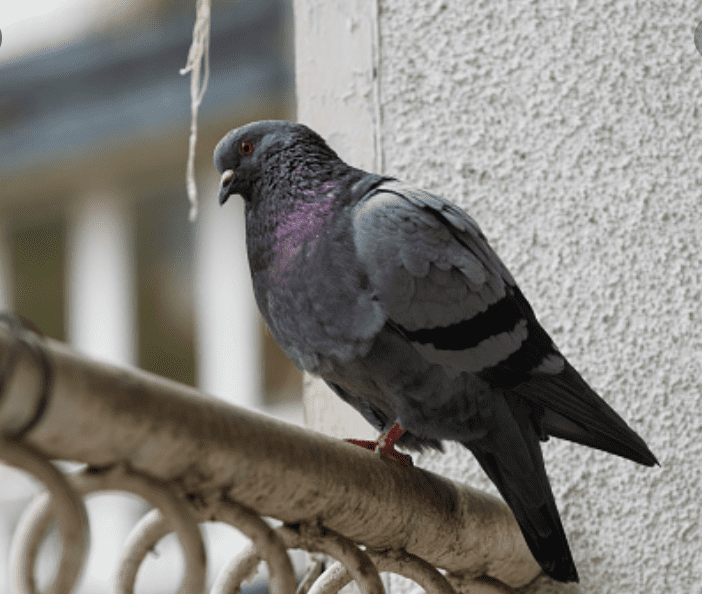
by Pigeon Patrol | Oct 26, 2020 | Animal Deterrent Products, Bird Deterrent Products, Bird Netting, Bird Spikes
Time to Expel The Nuisance (Pigeons)
Expel the pigeons : Many bird lovers like to attract beautiful little songbirds onto their balcony using bird feeders, helping to keep the feathered visitors fed during the winter while enjoying the chance to watch them at the same time. Pigeons, however, are rarely such a welcome guest as their invasion has consequences: damaged plants and traces of excrement as far as the eye can see – not how a cosy open-air oasis is meant to look. Their collective cooing can also really get on your nerves. Some of the birds may even carry diseases – so there are plenty of reasons why you are better off banishing pigeons from your balcony if their visits get out of control.
Visual measures to get pigeons off your balcony
Try to drive the birds away using various visual techniques. The birds are generally thought to be quite clever and fearless, so visual measures will only work in the short term. You should therefore regularly move the pigeon scaring device to a new position. This confuses the birds.
- Fake birds. Who is afraid of the vicious raven? Pigeons. Place a plastic version of the pigeon’s enemy on the balcony to scare the birds off. This also works with hawks, owls and buzzards. Always remember to reposition the pigeon scaring device from time to time. If you have an outdoor cat or a dog, even better. The birds like to keep a safe distance from pets and will therefore stay well away from your balcony
- Hang CDs. A cool retro look, with a purpose. Thread the CDs onto a fishing line. When you hang the mobile on your balcony, if all goes to plan then the reflective surfaces moving in the wind will scare the pigeons and they will fly away
- Aluminium foil. Similar principle to the CDs. Cut long strips of aluminium foil and hang them on the balcony. The fluttering strips reflecting the light will confuse the pests
- Glitter balls. You can also create light reflections to scare away the birds using shiny balls made from glass or plastic. Attached to a wooden stick, these useful defence systems can simply be stuck in a flower bed or plant pot
- Windmills. These contraptions make uncontrolled movements and this scares away the pigeons.
Acoustic and haptic systems to get pigeons off your balcony
Acoustic defence systems are usually only effective for a limited time. Pigeons quickly get used to noises and are then no longer disturbed by them. You should therefore constantly vary the tone to ensure that this method is successful. Dog barks, cries from birds of prey or loud bangs, which sound like they are random, are good examples of effective noises. However, it’s likely that your neighbours will also not particularly enjoy these noises – this measure must not degenerate into a noise nuisance.
Haptic systems offer more promise.
- Nets. Although these do ruin the view, the upside is that pigeons will no longer be able to rest on your balcony.
- Spikes. These are not just found on sports shoes worn by athletes – they are also an effective pigeon defence system. You can buy spikes in DIY shops and attach them to your balcony, preventing the birds from landing. The disadvantage is that your balcony no longer looks so nice. You can now also get spike borders, which are made from plastic. These can be attached to your balcony railings – if don’t mind the slightly military-like view.
Removing pigeon nests from your balcony
If pigeons start to nest on your balcony, you should remove the nests quickly – and always wear gloves and a face mask when doing so. Otherwise, a whole clan could settle on your balcony and it will become more and more difficult to get rid of them. It’s tricky if the birds are already breeding. In this case, you should seek help from a professional. Contact us today!
Protecting your birdhouses from pigeons
Back to the issue of birdhouses: these shelters intended for members of the tit family and other small birds are also popular with pigeons, who steal the food away from the smaller birds during the winter. You should therefore protect the source of food from unwelcome visitors. All you need to do is to run a piece of string or wire through the middle of the opening to the house. The small birds will still be able to get into the house, but the entrance will be blocked to pigeons. Hanging bird-feeder rings do not generally need extra protection because pigeons are too big to perch on them and feed.
source
About Pigeon Patrol:
Pigeon Patrol Products & Services is the leading manufacturer and distributor of bird deterrent (control) products in Canada. Pigeon Patrol products have solved pest bird problems in industrial, commercial, and residential settings since 2000, by using safe and humane bird deterrents with only bird and animal friendly solutions. At Pigeon Patrol, we manufacture and offer a variety of bird deterrents, ranging from Ultra-flex Bird Spikes with UV protection, Bird Netting, 4-S Gel and the best Ultrasonic and audible sound devices on the market today.
Contact us at 1- 877– 4– NO-BIRD, (604) 585-9279 or visit our website at www.pigeonpatrol.ca
Bird Gone, Pigeon Gone, Seagull Gone, Pigeon problems, pigeon spikes, 1-877-4NO-BIRD, 4-S Gel, Bird Control, Pigeon Control, bird repellent, Bird Spikes, bird law sonic bird repellent, stainless steel bird spikes, bird spikes Vancouver, Ultra Sonic Bird Control, Bird Netting, Plastic Bird Spikes, Canada bird spike deterrents, Pigeon Pests, B Gone Pigeon, Pigeon Patrol, pigeon family pest controller, pest control operator, Bird law pest control technician, Pigeon Control Products, humane pigeon spikes, pigeon deterrents, type of birds, pigeon traps, Pigeon repellents, Sound & Laser Deterrents, wildlife control, raccoon, skunk, squirrel deterrent, De-Fence Spikes, Dragons Den, Canada bird spikes, Pigeon behavior ,Canada pigeon, pigeon control, pigeon patrol, pigeon. Kill pigeons, crow, starling, Pigeon Habitat, Expel pigeons
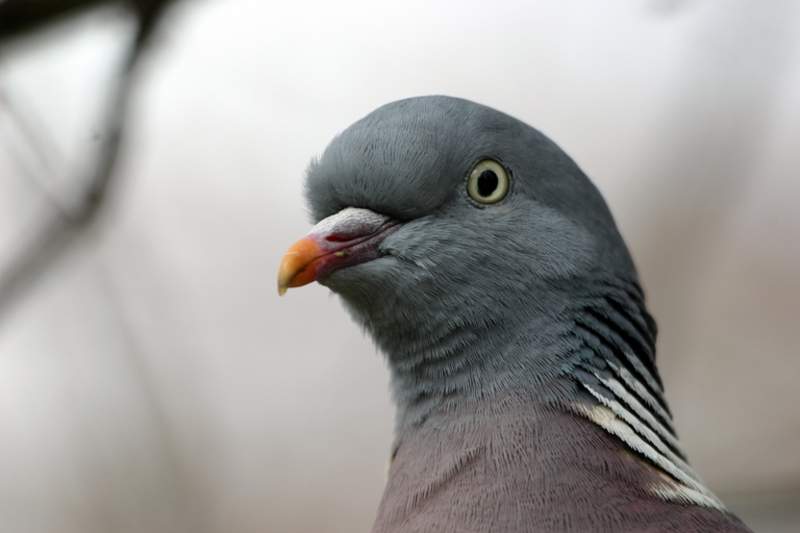
by Pigeon Patrol | Oct 26, 2020 | Bird Deterrent Products, Bird Netting, Bird Spikes, Pigeon Control, Pigeon Patrol's Services
Pigeon Family Life
Pigeons and their family live in groups called “flocks.” Each flock has an equal number of male and female members. A courting male pursues his intended mate on the ground, circling her, with his neck feathers inflated and his tail spread, bowing and cooing all the while. Pigeons mate for life, but if one partner dies the survivor generally will attempt to find another mate.
Pigeons show a strong affinity for human-built structures. Nests, a haphazard combination of twigs, leaves, and a few feathers, are built on window ledges, behind signs, and under bridges. Parents take turns incubating the clutch of one or two white, unmarked eggs for between 16 and 19 days. After the eggs hatch, both parents feed the baby pigeons, or squabs, a crop secretion called “pigeon milk,” which is produced from the lining of the crop, a sac-like food storage chamber located under the bird’s esophagus. The milk is a highly nutritious and an efficient way of feeding young. Squabs fledge at four to six weeks of age but remain dependent on their parents for as long as the adults will tolerate them — generally another one or two weeks. Individuals may be capable of breeding at six months of age.
Pigeons leave their nesting and roosting sites during daylight hours to search for food, but they return at night, as well as periodically during the day when raising young.
source
About Pigeon Patrol:
Pigeon Patrol Products & Services is the leading manufacturer and distributor of bird deterrent (control) products in Canada. Pigeon Patrol products have solved pest bird problems in industrial, commercial, and residential settings since 2000, by using safe and humane bird deterrents with only bird and animal friendly solutions. At Pigeon Patrol, we manufacture and offer a variety of bird deterrents, ranging from Ultra-flex Bird Spikes with UV protection, Bird Netting, 4-S Gel and the best Ultrasonic and audible sound devices on the market today.
Contact us at 1- 877– 4– NO-BIRD, (604) 585-9279 or visit our website at www.pigeonpatrol.ca
Bird Gone, Pigeon Gone, Seagull Gone, Pigeon problems, pigeon spikes, 1-877-4NO-BIRD, 4-S Gel, Bird Control, Pigeon Control, bird repellent, Bird Spikes, bird law sonic bird repellent, stainless steel bird spikes, bird spikes Vancouver, Ultra Sonic Bird Control, Bird Netting, Plastic Bird Spikes, Canada bird spike deterrents, Pigeon Pests, B Gone Pigeon, Pigeon Patrol, pigeon family pest controller, pest control operator, Bird law pest control technician, Pigeon Control Products, humane pigeon spikes, pigeon deterrents, type of birds, pigeon traps, Pigeon repellents, Sound & Laser Deterrents, wildlife control, raccoon, skunk, squirrel deterrent, De-Fence Spikes, Dragons Den, Canada bird spikes, Pigeon behavior ,Canada pigeon, pigeon control, pigeon patrol, pigeon. Kill pigeons, crow, starling, Pigeon Habitat,
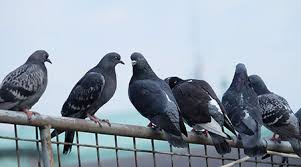
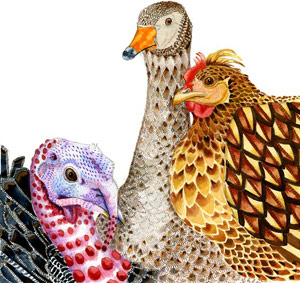
by Pigeon Patrol | Oct 26, 2020 | Bird Deterrent Products, Bird Netting, Pigeon Control, Pigeon Patrol's Services
Guide To Type Of Birds: Maybe it’s due to the fact that birds were a central component of my household for many years (parakeets), but birds are often on my mind. Everyone romanticizes birds because of their ability to fly. Yes, flight is awesome, that’s why we invented the airplane. Bats and bugs fly, but rarely are those animals included on anyone’s list of “animals I’d like to be.” Oh, I wish I were a bird, then I could fly anywhere and be with other birds to peck at millet or something. I’m really happy I’m not a bird. If you were a bird then flying would be normal, and you wouldn’t understand that you were flying because you’d be a stupid bird. The only thing you would think about is probably some form of seed or worm, and its proximity to your beak. The rest of your time would be spent squawking, tweeting, or cawing for extended periods of time about nothing in particular.
Crows are apparently some of the “smartest” birds, which is like being the “most athletic” cripple.This is not meant as an assault on birds; anything but. I’m just laying out the facts as I see them. I love birds. Birds are hilarious. One of my fondest memories of visiting Spain was when I hit this pigeon with a rolled-up newspaper in a courtyard. It was awesome for some reason. Hitting any other animal with a rolled-up newspaper would be much less funny (including a human), but birds have that bit of comedic magic that puts their reactions above and beyond. If you haven’t laughed at a bird before, maybe you should look a little closer. If you still don’t think birds are Earth’s comedic gift to us (along with many other things; Jewish comedy writers mostly), then you should reexamine your sense of humor.
Let’s face it, birds are really stupid. Chickens, turkeys, and ducks are especially stupid for allowing themselves to be bred and murdered by the millions every day, but let us not excuse the less-notably stupid, but still fascinatingly dumb members of the bird kingdom. I think I could break down all groups of birds into a few distinct categories, and this will be the new biologist’s guide to understanding and analyzing birds and their behavior, and general stupidity and ridiculousness.
Group #1: Birds we eat a lot of.
Examples: Chickens, ducks, turkeys, maybe some geese if you’re in 19th century Britain.

These birds are really stupid and extremely funny. One time we put a live chicken in my friend’s room while he was out, and he came back in and freaked out. Just the mere presence of a chicken demands a mirthful response. Look at the greatest comedy props of all time: the whoopie cushion and the rubber chicken. They both appeal to the most primal of human comedic needs. The whoopie cushion is great because it makes a farting sound, and the rubber chicken is great because it looks like a chicken and that’s just funny. Eating chicken is awesome too, and they also lay eggs which I eat a ton of. These two points are not funny, but should be noted to access the chicken’s overall value to human society.
All ducks look partly confused but generally in the moment and satisfied. Ducks seem to need human names like Roger, Stanley, and Ralph. The “quack” is also a very underrated bird noise. In my opinion it sits just above a goose “honk,” and right below a crow’s “caw” on the bird noise hierarchy. Famous ducks include Donald, Daffy, and the Aflac duck.
Turkeys are funny because they are so awkward. I know turkeys in factory farms are pretty messed up, so to appreciate good turkey humor you have to see wild turkeys. They’re kind of scary but at the same time, whatever, they’re stupid turkeys. In English, the word “turkey” is used to describe someone of questionable intelligence and above-average awkwardness. Benjamin Franklin wanted to make this our national bird instead of the bald eagle—one of the many reasons I don’t really like Benjamin Franklin.
Group #2: Birds that hang out near people and annoy them.
Examples: Pigeons, crows, seagulls.
These are perhaps the funniest birds because they’re so annoying and stupid. What’s better than watching a seagull or pigeon swoop in out of nowhere and steal French fries from beachgoers and random middle-aged people? Pigeons are everywhere around the world and they bob their heads when they walk. This is pretty funny. How did pigeons get to so many different places? I think maybe world leaders back in the day got together and had a summit about bringing more generic comedy into cities worldwide. Unanimously they agreed that these stupid birds could bring cultures together better than anything else.
Crows are apparently some of the “smartest” birds, which is like being the “most athletic” cripple. I’d rather be a stupid human than a “smart” bird. Have you ever heard one of those obnoxious crows that just keeps on cawing, and eventually it becomes some bastardized version of the original caw? It starts as your formal CAW CAW before descending into RAW WAW AWWWWWWW. I still remember waking up to the stupidest cawing I’ve ever heard back in eighth grade. Crows are really funny.
Seagulls always steal stuff from people, but it’s fun to throw bottles at them. I love when people get angry at you for hitting a seagull with something when you’re at the beach. People defend seagulls so much until they’re actually robbed by one of these ridiculous creatures. Now there’s a cause to really get behind, save the seagulls.
Group #3: Birds that kill rodents on nature shows.
Examples: Eagles, hawks, owls.
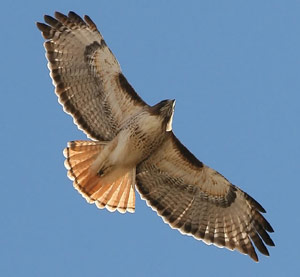
In my opinion, this is the only group of birds that I can consider “badass.” I know there are obvious outliers like certain carnivorous birds in Australia or something, but I really don’t care. I love seeing these birds kill stuff on nature shows, and if I had to make any bird really big so I could saddle it and ride it, it would probably be an eagle. Eagles are the symbol of America, and that’s pretty cool.
Hawks like to fly in circles over random places so people will stop and say, “Oh, look at that hawk! I wonder what he’s flying over?” He’s flying over a bunch of people who care about seeing a hawk fly in circles. Congratulations on feeding a hawk’s ego.
Owls are really wise for birds. I know this because they somehow convinced all fourth graders that it was reasonable to dissect their puke for science class.
Group #4: Big, dumb flightless birds.
Examples: Ostriches, emus, penguins, kiwis, peacocks.
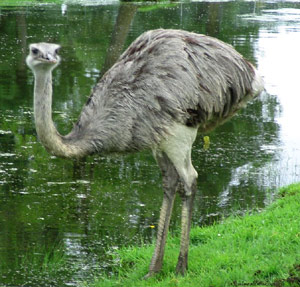
These birds taste better than those in Group 1, but people don’t give them enough credit for that. I’ve never tasted penguin, but I suppose it may be a bit fishy. Either way, ostrich is delicious. These birds could probably mess some stuff up if you left them alone in your apartment. They would probably walk around scratching and pecking at stuff with their awkward bodies until everything broke. I think that’s inconsiderate, but big, dumb, flightless birds don’t know any better.
This group is synonymous with stupidity. Dodo’s were big, dumb flightless birds that eventually became too stupid to live on the island of Mauritius and subsequently rendered themselves extinct. I’ve met a bunch of emus, and each one was really unintelligent. They can barely hold a conversation, let alone begin to write an essay or solve a math problem. Purely idiotic creatures.
Penguins get a lot of credit for mating and living where it’s cold. They’re also acknowledged for sort of looking like they are wearing tuxedos. I would like to see a penguin actually wearing a tuxedo tailored to its proportions. It would have such a difficult time doing anything penguiny, and that would be comedy gold.
Group #5: Pet birds that may be able to talk.
Examples: Cockatiels, parrots, parakeets.
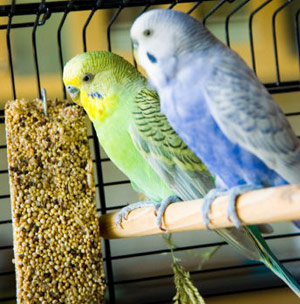
I’ve had a lot of experience with these types of birds. I lived with a number of parakeets for many years. They like to squawk and annoy people who aren’t used to them. They can also smell fear like dogs, and will pester those that find them most repellent.
Parrots have tricked a lot of people into thinking they’re smart because they can speak some English. I don’t buy into the parrot hype. They kind of creep me out. If I wanted to hear words over and over again, I would just say those words over and over. Or, in the true nature of parrots, I would just record my voice and whenever I needed a little dose of language, I would just play the recording. Everyone I know speaks better human language than parrots (this may be because I don’t personally know any infants right now), so maybe stop giving them so much credit and they won’t cost $1,500 at Petco.
Group #6: Birds that people like to see and know the names of, but are generally useless otherwise.
 Examples: Cardinals, robins, goldfinches.
Examples: Cardinals, robins, goldfinches.
These birds are cool because they can make anyone sound like a birdologist at any given moment. “Ooh, look at that cardinal! You know it’s a male because it’s bright red; the females are less brightly colored.” This is a great way to sound smart by regurgitating well-known knowledge as if it were the result of years of consistent bird-study. Robins are good because it’s my mother’s name, as well as the name of Batman’s gayboy sidekick. They also mean spring is here, or something.
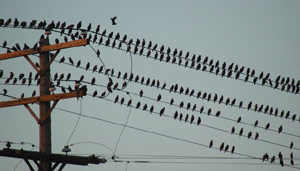
Group #7: All the little black birds that hang out on power lines and no one really cares about.
Examples: Those little black birds that hang out on power lines that I don’t know the names of.
Sometimes a bunch of these things will fly all at once off of a power line. It makes you feel like you’re in a movie where something really epic and scary is about to happen. No large group of birds is better at being ominous and setting the stage for something badass. Other than that, these birds are pretty useless.
Group #8: The peregrine falcon.
Yeah, it gets its own category for some reason.
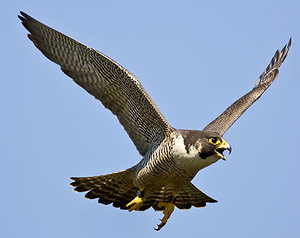
This bird is “the fastest animal in the world,” though here’s another bird fallacy I don’t buy into. Barring humans (the actual fastest animal in the world; we have planes and rocket ships, those are way faster than falcons), I still give the “fastest” card to the cheetah. Peregrine falcons are just sort of plummeting when people test their speed. It’s not like this thing is flapping its way to the record, it’s just falling and flapping simultaneously. Just because it can control itself while falling doesn’t mean it deserves the title. Still, this bird is badass for killing doves in midair and having a really intense and dramatic stare.
So there you have it: the 8 distinct type of birds, meticulously categorized and analyzed for the scientific community. I hope you feel a newfound respect for these hilarious, not-at-all mysterious, omnipresent creatures.
source
About Pigeon Patrol:
Pigeon Patrol Products & Services is the leading manufacturer and distributor of bird deterrent (control) products in Canada. Pigeon Patrol products have solved pest bird problems in industrial, commercial, and residential settings since 2000, by using safe and humane bird deterrents with only bird and animal friendly solutions. At Pigeon Patrol, we manufacture and offer a variety of bird deterrents, ranging from Ultra-flex Bird Spikes with UV protection, Bird Netting, 4-S Gel and the best Ultrasonic and audible sound devices on the market today.
Contact us at 1- 877– 4– NO-BIRD, (604) 585-9279 or visit our website at www.pigeonpatrol.ca
Bird Gone, Pigeon Gone, Seagull Gone, Pigeon problems, pigeon spikes, 1-877-4NO-BIRD, 4-S Gel, Bird Control, Pigeon Control, bird repellent, Bird Spikes, bird law sonic bird repellent, stainless steel bird spikes, bird spikes Vancouver, Ultra Sonic Bird Control, Bird Netting, Plastic Bird Spikes, Canada bird spike deterrents, Pigeon Pests, B Gone Pigeon, Pigeon Patrol, pest controller, pest control operator, Bird law pest control technician, Pigeon Control Products, humane pigeon spikes, pigeon deterrents, type of birds, pigeon traps, Pigeon repellents, Sound & Laser Deterrents, wildlife control, raccoon, skunk, squirrel deterrent, De-Fence Spikes, Dragons Den, Canada bird spikes, Pigeon behavior ,Canada pigeon, pigeon control, pigeon patrol, pigeon. Kill pigeons, crow, starling, Pigeon Habitat,
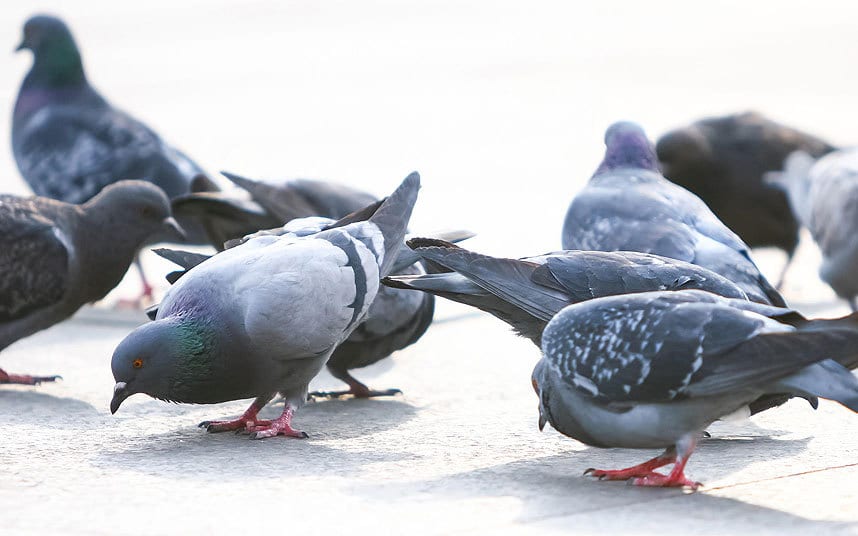
by Pigeon Patrol | Oct 21, 2020 | Animal Deterrent Products, Bird Deterrent Products, Bird Netting, Bird Spikes, Pigeon Patrol's Services, Pigeon Spikes
Pigeon Behavior
Most birds take a sip of water and throw back their heads to let the water trickle down their throats. But pigeons (and all of their relatives in the family Columbidae) suck up water, using their beaks like straws.
Pigeon Behavior: Do pigeons have compasses in their heads? Not really, but pigeons, especially those bred for their homing instincts, seem to be able to detect the Earth’s magnetic fields. Cornell University pigeon researcher Dr. Charles Walcott says that magnetic sensitivity, along with an ability to tell direction by the sun, seems to help pigeons find their ways home.
On the ground, pigeons don’t hop the way many birds do. They walk or run with their heads bobbing back and forth. Pigeons are strong fliers and can fly up to 40 or 50 miles per hour. Some pigeons are raised for their exceptional abilities to fly fast and find their ways home. These pigeons may fly as far as 600 miles in a day. Although feral pigeons are good fliers too, most of these birds seem to stay close to their regular feeding sites.
As gregarious animals, feral pigeons tend to nest in flocks. Once they settle, they tend to nest at the same place for the rest of their lives. Pigeons are extraordinarily intelligent. Even when removed from the nest, they will return back to it. The distance doesn’t play a role—pigeons have “built-in” compasses in their bodies which provide tremendous help with orientation. No matter how far away from their home they are released, they will still find their way back.
Feral pigeons breed rapidly. They lay two eggs, up to six times a year—depending on the food available. If a local population is decreased, pigeons from other areas flock to take advantage of the abundance of food. Thus, poison often causes population boom rather than decrease.

Natural Predators
Man is by far the greatest predator of pigeons. Yet they also have plenty of other predators too including Falcons, Sparrow, hawks, Owls, Foxes, Ferrets, Snakes, Rats, Cats, Dogs and more.
One species of falcon, Merlin, eats so many pigeons its scientific name is Falco columbaries (with the “Columba-” meaning pigeon) and it was formerly called pigeon hawk. Merlin’s are medium-sized falcons and although they are not very common in cities, you can bet they are preying on pigeons living in open parks near marshes and ponds.They are small and quick and they tend to prefer park areas rather than high towers. They hide in trees, or drop down from light posts. The one I saw took his pigeon back up to a tree and the only evidence was a few feathers drifting down occasionally. I only ever saw that once, but I know they are around. I bet you have them too. Another falcon that is a natural predator of the pigeon is the peregrine falcon, a bird that can achieve speeds of up to 200 miles per hour in a dive and one of the few birds that has the speed and the maneuverability to outpace and catch a pigeon in flight. In North America some big cities have wild Peregrine Falcons. These falcons like to nest on high cliffs, and city high rises work too. There is a famous pair in San Francisco, for example. Whenever these birds find a ledge to nest on, the Eagle-cam team is usually not far behind.

Source
About Pigeon Patrol:
Pigeon Patrol Products & Services is the leading manufacturer and distributor of bird deterrent (control) products in Canada. Pigeon Patrol products have solved pest bird problems in industrial, commercial, and residential settings since 2000, by using safe and humane bird deterrents with only bird and animal friendly solutions. At Pigeon Patrol, we manufacture and offer a variety of bird deterrents, ranging from Ultra-flex Bird Spikes with UV protection, Bird Netting, 4-S Gel and the best Ultrasonic and audible sound devices on the market today.
Contact us at 1- 877– 4– NO-BIRD, (604) 585-9279 or visit our website at www.pigeonpatrol.ca
Bird Gone, Pigeon Gone, Seagull Gone, Pigeon problems, pigeon spikes, 1-877-4NO-BIRD, 4-S Gel, Bird Control, Pigeon Control, bird repellent, Bird Spikes, bird law sonic bird repellent, stainless steel bird spikes, bird spikes Vancouver, Ultra Sonic Bird Control, Bird Netting, Plastic Bird Spikes, Canada bird spike deterrents, Pigeon Pests, B Gone Pigeon, Pigeon Patrol, pest controller, pest control operator, Bird law pest control technician, Pigeon Control Products, humane pigeon spikes, pigeon deterrents, pigeon traps, Pigeon repellents, Sound & Laser Deterrents, wildlife control, raccoon, skunk, squirrel deterrent, De-Fence Spikes, Dragons Den, Canada bird spikes, Pigeon behavior ,Canada pigeon, pigeon control, pigeon patrol, pigeon. Kill pigeons, crow, starling, Pigeon Habitat,

by Pigeon Patrol | Oct 20, 2020 | Pigeon Control, Pigeon Patrol's Services, Pigeons in the News
Facts About The Pigeon
If you live on earth, chances are you’ve seen a pigeon before, if not on the daily. But do you really know anything about the pigeon other than the fact that they leave their droppings everywhere? (Which could be really annoying. Check out our products here https://www.pigeonpatrol.ca/) Here are 5 cool facts about pigeons you may have not known!
1) AT ONE POINT, MORE THAN ONE-QUARTER OF ALL THE BIRDS LIVING IN THE U.S. MAY HAVE BEEN PASSENGER PIGEONS
The passenger pigeon or wild pigeon is an extinct species of pigeon that was endemic to North America. Its common name is derived from the French word passager, meaning “passing by”, due to the migratory habits of the species. The scientific name also refers to its migratory characteristics
Wild/feral rock pigeons reside in all 50 states, which makes it easy to forget that they’re invasive birds. Originally native to Eurasia and northern Africa, the species was (most likely) introduced to North America by French settlers in 1606. At the time, a different kind of columbiform—this one indigenous—was already thriving there: the passenger pigeon (Ectopistes migratorius). As many as 5 billion of them were living in America when England, Spain, and France first started colonizing, and they may have once represented anywhere from 25 to 40 percent of the total U.S. bird population. But by the early 20th century, they had become a rare sight, thanks to overhunting, habitat loss, and a possible genetic diversity issue. The last known passenger pigeon—a captive female named Marth who died on September 1, 1914.

SOURCE
2) THEY CAN FIND THEIR WAY BACK TO THE NEST FROM OVER 2000KM AWAY
Another cool fact about pigeons is they have extraordinary navigational abilities. Take a pigeon from its loft and let it go somewhere it has never been before and it will, after circling in the sky for while, head home. This remarkable capacity extends to places tens even hundreds of kilometers from its home and is all the more remarkable to humans because we are apparently incapable of it ourselves.
But we have long made use of the pigeon’s homing ability, principally for carrying messages in the past. And for several decades now the pigeon has played center stage in scientists’ attempts to understand the map and compass mechanisms fundamental to bird navigation.
We’ve now learn that pigeons repeatedly released from the same site soon learn a habitual route home which they stick to faithfully even if it is not the quickest. Different individuals learn, and stick to, different routes. Routes often follow linear landscape features, such as roads or field margins, but are learnt most effectively over landscapes of intermediate complexity. This means that urban landscapes may in fact be too complex for optimum route learning.
Pair birds with different ideas about how to get home from the same place and the result is an elegant exposé of each bird’s propensity to lead out or follow others. Birds that are more faithful to their own route when homing alone are more likely to emerge as leaders when homing socially.
So if the pigeon’s brain contains a network of learnt routes, how are these memories acquired and how do they interact? Recently, my colleagues Andrea Flack and Dora Biro showed that having to learn three routes in parallel doesn’t cause pigeons any additional confusion. Route-learning is memorized independently, regardless of whether the sites they are released from are encountered sequentially, randomly intermingled or in strict rotation.
Treating the art of pigeon homing as a natural learning laboratory is a new science into which we are just taking the first steps, and it seems that we have yet to find the boundaries of the bird’s abilities. Clearly, we still have much to learn from the pigeon.
On to the next pigeon facts
3) PIGEONS WERE USED AS MESSENGERS
Pigeons were effective as messengers due to their natural homing abilities. The pigeons were transported to a destination in cages, where they would be attached with messages, then the pigeon would naturally fly back to its home where the recipient could read the message.
The earliest large-scale communication network using pigeons as messengers was established in Syria and Persia around the 5th century BC. Much later, in the 12th century AD, the city of Baghdad and all the main towns and cities in Syria and Egypt were linked by messages carried by pigeons. This was the sole source of communication. In Roman times the pigeon was used to carry results of sporting events, such as the Olympic Games, and this is why white doves are released at the start of the Olympic Games today. In England, prior to the days of telegraphs, pigeons were often taken to football matches and released to carry home the result of the game. Their use as a messenger in wartime resulted in many pigeons being awarded honors by both the British and French Governments. Incredibly, the last ‘pigeon post’ service was abandoned in India in 2004 with the birds being retired to live out the rest of their days in peace.
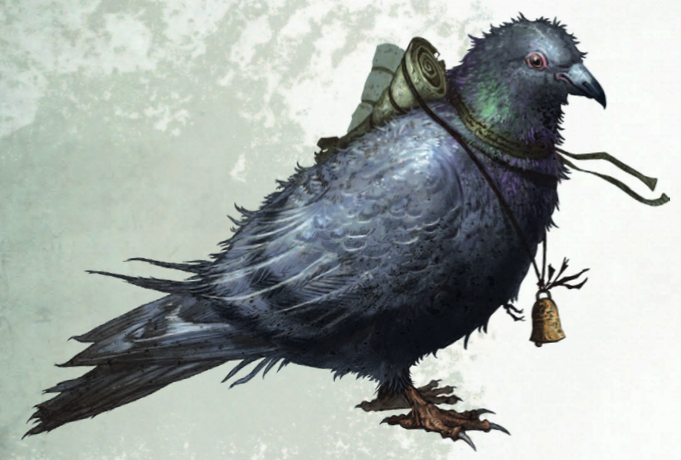
4) THEY SAVED THOUSANDS OF HUMAN LIVES DURING WORLD WARS I AND II.
Pigeons’ homing talents continued to shape history during the 20th century. In both World Wars, rival nations had huge flocks of pigeon messengers. (America alone had 200,000 at its disposal in WWII.) By delivering critical updates, the avians saved thousands of human lives. One racing bird named Cher Ami completed a mission that led to the rescue of 194 stranded U.S. soldiers on October 4, 1918.
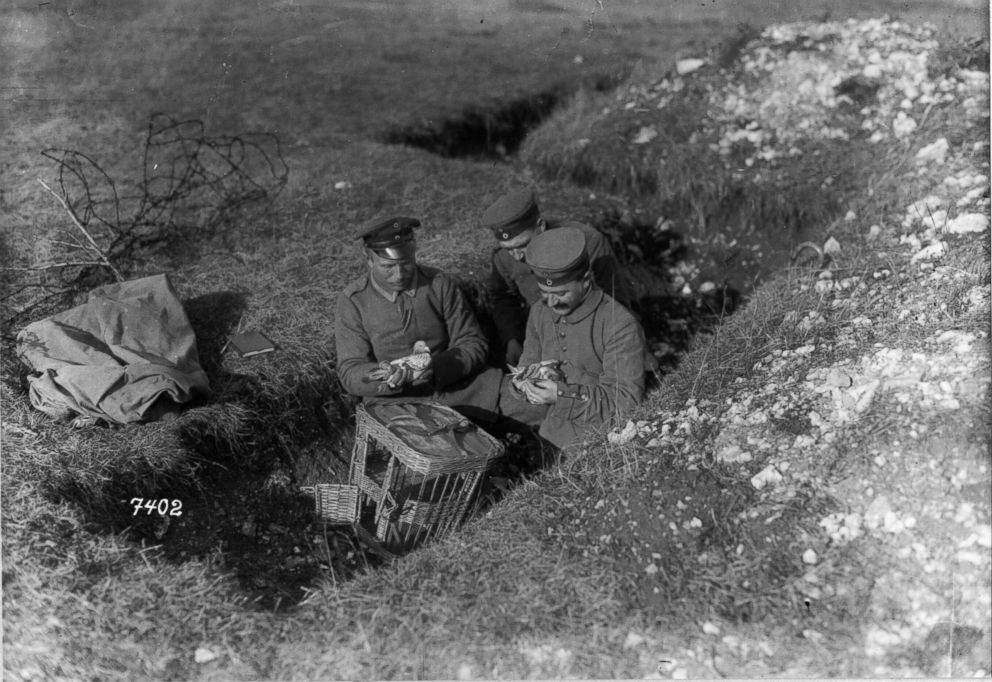
5) THEY MIGHT BE THE FIRST DOMESTICATED BIRD.
The common city pigeon (Columba livia), also known as the rock pigeon, might be the first bird humankind ever domesticated. You can see them in art dating back as far as 4500 BCE in modern Iraq, and they’ve been a valuable source of food for thousands of years. The rock pigeon is the world’s oldest domesticated bird. Mesopotamian cuneiform tablets mention the domestication of pigeons more than 5,000 years ago, as do Egyptian hieroglyphics. Research suggests that domestication of pigeons occurred as early as 10,000 years ago.
And there you have it! 5 Cool facts about pigeons! Which one was new to you?
About Pigeon Patrol:
Pigeon Patrol Products & Services is the leading manufacturer and distributor of bird deterrent (control) products in Canada. Pigeon Patrol products have solved pest bird problems in industrial, commercial, and residential settings since 2000, by using safe and humane bird deterrents with only bird and animal friendly solutions. At Pigeon Patrol, we manufacture and offer a variety of bird deterrents, ranging from Ultra-flex Bird Spikes with UV protection, Bird Netting, 4-S Gel and the best Ultrasonic and audible sound devices on the market today.
Contact us at 1- 877– 4– NO-BIRD, (604) 585-9279 or visit our website at www.pigeonpatrol.ca
Bird Gone, Pigeon Gone, Seagull Gone, Pigeon problems, pigeon spikes, 1-877-4NO-BIRD, 4-S Gel, Bird Control, Pigeon Control, bird repellent, Bird Spikes, sonic bird repellent, stainless steel bird spikes, bird spikes Vancouver, Ultra Sonic Bird Control, Bird Netting, pigeon facts Plastic Bird Spikes, Pigeon Fact, Canada bird spike deterrents, Pigeon Pests, B Gone Pigeon, Pigeon Patrol, pest controller, pest control operator, pest control technician, Pigeon Control Products, humane pigeon spikes, pigeon deterrents, pigeon traps, Pigeon repellents, Sound & Laser Deterrents, wildlife control, pigeon facts raccoon, skunk, squirrel deterrent, De-Fence Spikes, Dragons Den, Canada bird spikes, Canada pigeon, pigeon control, pidgon patrol, pigeon. Kill pigeons, crow, starling, Pigeon Habitat, Cool Facts About Pigeons, Pigeon Facts

by Pigeon Patrol | Oct 20, 2020 | Bird Deterrent Products, Pigeon Control
Budget Friendly Pigeon Deterrents
Looking to try more pigeon deterrents to see which one works best for you? First off, Pigeons have excellent eyesight & are startled by unexpected visual signals or recognizable predators. Here are 3 budget friendly bird deterrent products that could help you keep these pests and other birds such as sparrows, and crows away from your property
1) Magnetic Bird Defender
Thanks to technological innovations, you can find several kinds of equipment to scare birds away. One is you can use this powerful magnet to repel the birds. This magnet is flashy and interferes with the birds’ sense of direction and confuses them which will cause them to stay away from the radius of the magnet’s field. The number of magnets or their strength will depend on the size of your property. Pigeons and other birds tend not to approach any area where there is a magnetic field stronger than the terrestrial magnetic field. You can hang these on your balcony, porch, front door, wherever these pests may be
Get your magnetic bird defender here https://www.pigeonpatrol.ca/product/magnetic-bird-defender/

Source
2) Reflective Owl Repellent
These owl repellents are budget friendly and effectively scares birds away because of the reflective print. The pigeon’s eye is one-half the weight of its brain, whereas man’s eye is only one-fiftieth of his brain weight. Pigeons have a very wide visual field of around 340° compared to the 180°of humans. So when they come across these reflective owls, there eyes get irritated and they can’t stand it. Another reason why these owls are effective is simple: Owls prey on pigeons and pigeons are not the smartest things on wings. Confronted with something that looks like an owl, a pigeon will assume the worst and fly away. The ruse is hardly new. For years, gardeners and boaters have used fake owls to scare off birds. This owl-shaped surface contains hundreds of three-dimensional light-refraction spots. When the sunshine comes to this surface, it is immediately reflected in various rays of colors. Additionally, each decoy is attached with two hawk bells, and these will unpredictably emit sounds to startle the birds
CALL US TO ORDER THESE REFLECTIVE OWLS (604) 585-9279

3) Reflective Ribbons
One of the classic and primary tools is the bird repellent tape, This is another bird control applying the refractive holographic technique on both sides. This tape is about 5 centimeters width and nearly 100 meters long, which is enough to cover my backyard. It does not consume much of my time and effort to hang up the tapes. I cut them into strips about 40 centimeters long, and stick them to the wall with layers of adhesive tapes, or tight with thin rope, dental floss, any kind of thin string appearing in my kitchen. Or I sometimes cut them into approximately one-meter strips and tight upon the tree branches. Actually, it is not compulsory to hang on the highest spots, but scare tape should be directly contacted with sun rays and wind so that they could flail wildly to create flashing light and flapping sound.
CALL US TO ORDER THESE REFLECTIVE TAPES (604) 585-9279
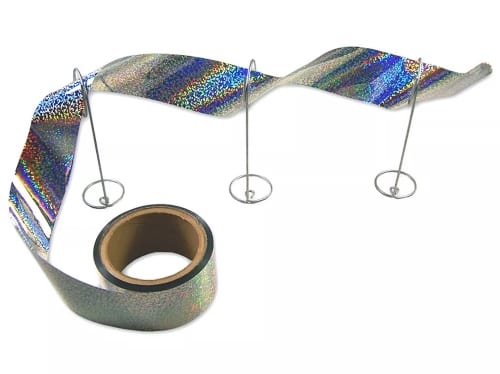
With visual deterrents, surprise & change are vital. Birds quickly acclimate to static scares, so we don’t sell them. Pigeon Patrol has these visual products that contain some element of change or movement, making them more effective than the stationary units offered in the marketplace. For large areas, use more visuals — either the same type or a variety. Change the location of your visual deterrents from time to time to maintain its effectiveness in keeping away the bird pests.
About Pigeon Patrol:
Pigeon Patrol Products & Services is the leading manufacturer and distributor of bird deterrent (control) products in Canada. Pigeon Patrol products have solved pest bird problems in industrial, commercial, and residential settings since 2000, by using safe and humane bird deterrents with only bird and animal friendly solutions. At Pigeon Patrol, we manufacture and offer a variety of bird deterrents, ranging from Ultra-flex Bird Spikes with UV protection, Bird Netting, 4-S Gel and the best Ultrasonic and audible sound devices on the market today.
Contact us at 1- 877– 4– NO-BIRD, (604) 585-9279 or visit our website at www.pigeonpatrol.ca
Bird Gone, Pigeon Gone, Seagull Gone, Pigeon problems, pigeon spikes, 1-877-4NO-BIRD, 4-S Gel, Bird Control, Pigeon Control, bird repellent, Bird Spikes, sonic bird repellent, stainless steel bird spikes, bird spikes Vancouver, Ultra Sonic Bird Control, Bird Netting, Plastic Bird Spikes, Canada bird spike deterrents, Pigeon Pests, B Gone Pigeon, Pigeon Patrol, pest controller, pest control operator, pest control technician, Pigeon Control Products, humane pigeon spikes, pigeon deterrents, pigeon traps, Pigeon repellents, Sound & Laser Deterrents, wildlife control, raccoon, skunk, squirrel deterrent, PIGEON DETERRENTS, De-Fence Spikes, Dragons Den, Canada bird spikes, Canada pigeon, pigeon control, pidgon patrol, pigeon. Kill pigeons, crow, starling, Pigeon Habitat

by Pigeon Patrol | Oct 20, 2020 | Bird Deterrent Products, Bird Netting, Bird Spikes, Pigeon Droppings, Pigeon Spikes
Danger of Pigeon Droppings
Although pigeons themselves are not considered to be a danger to humans, their droppings is a different story. Pigeons transmit diseases through their droppings and can easily affect someone with a weakened immune system if near by.
Pigeon droppings that are infected with bacteria or viruses are often left on the street, windowsills and cars to dry out. Once they do, they become a powder, which is blown or kicked into the air and then inhaled. The inhalation of this powder is one way that the pathogens that can cause disease can be spread to us.
Pathogens
According to Medical News Today, the most common pathogens which can cause disease transmitted from pigeons to humans are:
- E. coli. This occurs when bird droppings land in a water or food supply and are then consumed by humans. This can typically be avoided by washing food thoroughly before eating. Symptoms include nausea, fever and cramps.
- St. Louis encephalitis.This disease is spread by mosquitoes after they feed on a bird that carries the pathogen that spreads St. Louis encephalitis. This inflammation of the nervous system is dangerous to all age groups, but can be particularly dangerous and even fatal in adults over 60 years old. Symptoms include drowsiness, headache and fever.
- Histoplasmosis.This respiratory disease occurs as a result of a fungus growing in pigeon droppings and can be fatal.
- Candidiasis.This disease is also a respiratory condition caused by a fungus or yeast found in droppings. The areas affected include skin, mouth, the respiratory system, intestines and the urogenital tract, particularly in women.
- Salmonellosis.This disease is commonly called “food poisoning” and spreads via infected droppings turning into dust and contaminating food and food preparation surfaces prior to consumption.
Pigeons are also carriers of mites, fleas, and West Nile virus, and all of which can cause discomfort and potentially serious health issues in humans.
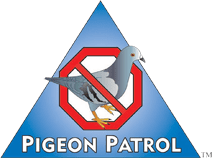
If you are cleaning up or come into contact with droppings, you should take precautions. Wash your hands and clean any exposed skin before eating, drinking or putting your hands near your mouth. Likewise, if you are feeding or handling birds, wash your hands afterwards. If you have a compromised immune system, including from HIV/AIDS or cancer, you should not clean up droppings.
Destroys Cleanliness of Property
Pigeon droppings are unsightly and can cause problems by making pavements and steps slippery, particularly in wet weather. Droppings can also corrode stonework and damage buildings. Nesting material, droppings and dead birds may block gutters and drains leading to water damage to buildings. Pigeon droppings are quite high in uric acid, which corrodes car exteriors like no one’s business. With an average pH of about 3, dried bird poop will peel away clearcoats, bleach paint, and leave cartoonish etchings of itself even after a car wash.
Pigeon droppings can cause severe damage to not just your roof but also other parts of your house. Some of the havoc birds poop can cause to your roof include:
Uric Acid
Bird poop contains uric acid, which can damage your roof. Since birds don’t urinate, the only way they could get rid of nitrogenous waste from their body system is through their poop. The acidic content of the white liquid can wreak havoc on materials like concrete, car paint, and roofing materials. The most vulnerable roof material to uric acid is the asphalt shingles.
Effect on Solar Panel
Roof-mounted solar panels have become a modern haven for pigeons and other bird species. This is so because solar panels provide warmth and shelter from the wind and rain. More so, it is a perfect spot for nesting, which ultimately results in massive bird dropping problems. Apart from the fact that these birds cause damage to the solar panel wiring, they also create a mess by leaving their droppings on top of them. These droppings, if left to sit for an extended period of time , blight solar panels and can render the system useless.
Blocked Gutters
Pigeons picking on dried poop for bugs can drop these waste into your gutters. These bird droppings contain seeds that may likely create additional problems for your drainage system. When a bird poop is left for long on your roof, wind or rain may eventually wash the bird poop and seeds into the gutters. These seeds can grow into weeds and shrubs in the gutter given the right conditions, thus affecting the flow of water. A clogged gutter will eventually lead to roof leakages. So make sure you clean your gutters regularly to ensure that they are free of debris and other waste products left by pigeons.
Moss Growth
Moss thrives in shady, damp places and are commonly found on the roof. Failure to tackle moss growth heads on can result in water leaks and damage. In addition, it can clog your drainage and gutters. Moss retains moisture, and this could further hamper the efficiency of your roof materials. What is for certain is that if birds and pigeons regularly leave droppings on your roof, the moss problem can be difficult and more expensive to contain. The nutrients from pigeon poop stimulate moss growth. More reasons why you need to get rid of pigeons and bird pests from your roof.
Bird Laws
Some laws protect native birds. So you need to follow laid down protocols when getting rid of them. Some of the legal methods of preventing birds nesting on your roof include roof spikes and bird deflectors. If you don’t want to face the wrath of the law, then make sure you contact reputable bird control service for assistance. Read More About Bird Laws Here
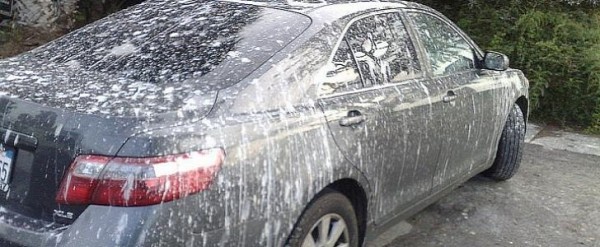
Source
About Pigeon Patrol:
Pigeon Patrol Products & Services is the leading manufacturer and distributor of bird deterrent (control) products in Canada. Pigeon Patrol products have solved pest bird problems in industrial, commercial, and residential settings since 2000, by using safe and humane bird deterrents with only bird and animal friendly solutions. At Pigeon Patrol, we manufacture and offer a variety of bird deterrents, ranging from Ultra-flex Bird Spikes with UV protection, Bird Netting, 4-S Gel and the best Ultrasonic and audible sound devices on the market today
Contact us at 1- 877– 4– NO-BIRD, (604) 585-9279 or visit our website at www.pigeonpatrol.
Bird Gone, Pigeon Gone, Seagull Gone, Pigeon problems, pigeon spikes, 1-877-4NO-BIRD, 4-S Gel, Bird Control, Pigeon Control, bird repellent, Bird Spikes, sonic bird repellent, stainless steel bird spikes, bird spikes Vancouver, Ultra Sonic Bird Control, Bird Netting, Plastic Bird Spikes, Canada bird spike deterrents, Pigeon Pests, B Gone Pigeon, Pigeon Patrol, pest controller, pest control operator, pest control technician, Pigeon Control Products, humane pigeon spikes, pigeon deterrents, pigeon traps, Pigeon repellents, Sound & Laser Deterrents, wildlife control, raccoon, skunk, squirrel deterrent, De-Fence Spikes, Dragons Den, Canada bird spikes, Canada pigeon, pigeon control, pidgon patrol, pigeon. Kill pigeons, crow, starling, Pigeon Habitat, Danger of Pigeon

by Pigeon Patrol | Oct 20, 2020 | Bird Law, MBCA, Pigeon Control, Pigeon Patrol's Services
What Is The Bird Protection Law?
Most species of birds in Canada are protected by the bird law under the Migratory Birds Convention Act, 1994 (MBCA). The MBCA was passed in 1917, and updated in 1994 and 2005, to implement the Migratory Birds Convention, a treaty signed with the United States in 1916. As a result, the Canadian federal government has the authority to pass and enforce regulations [Migratory Birds Regulations (C.R.C., c. 1035)] to protect those species of birds that are included in the Convention. Similar legislation in the United States [Birds Protected By The Migratory Bird Treaty Act] protects birds species found in that country, though the list of bird species protected by each country can be different.
“Migratory birds” are defined by Article I of the Convention which names the families and subfamilies of birds protected, and provides some clarification of the species included. This list is provided as a policy interpretation of Article I. Bird species not listed here may, or may not, be protected under provincial or territorial legislation, the Convention on Biodiversity, or the Species at Risk Act (2002). Persons making any decisions regarding the protected status of a bird species in Canada should consult these other statutes. Environment and Climate Change Canada requires that all three criteria below be met to qualify a species for the list of bird species protected in Canada under the MBCA.
Protected Birds
Most Common Protected Birds
- Swallows.These birds generally have a short bill, long pointed wings, and a deeply forked tail. They arrive seasonally and build their mud nests under eaves and patio covers. Swallows fly to and from their nests thousands of times a day and employ “aerial foraging” to capture flying insects in their beaks.
- Woodpeckers. These sharp-billed birds tap trees and wood surfaces an average of 8,000-12,000 times per day, leaving deep, round holes 3 to 5cm in diameter. They generally have a very long tongue (up to four inches) with a glue-like substance on the tip for catching insects. They also have bristle-like feathers over their nostrils to keep wood particles from being inhaled.
- Canada Geese. These large birds feed on grasses, sedges, waste grain and berries. They can see more than 180 degrees horizontally and vertically, and they can travel more than 1,000 kilometers a day while migrating. Some geese live up to 24 years in the wild. The birds can cause major damage to turf grass due to foraging and fecal contamination. A single goose can defecate every 20 minutes and leave up to 1.5 pounds each day.
- Gulls.These large, clever birds can drink both fresh and salt water. They vary in size from the Little Gull (120 g and 29 cm) to the large Great Black-Beaked Gull (1.75 kg and 75 cm). They will eat seed, fruit and leftovers of human meals. The mounds of gull droppings can damage boats, streetlights and coastal rooftops. The bacteria, fungal agents and ectoparasites found in gull droppings can carry such diseases as histoplasmosis, encephalitis, salmonella and meningitis.
Unprotected Birds
Unprotected birds include the Pigeon, House Sparrows, & European Starling. They are not covered in the bird law
Pigeons are the largest of the 3 species, at about 12 inches long, and weigh 12 to 17 ounces. They typically are blue-gray with 2 black bands on the wings, and a black band on the tail that contrasts with its white rump (Figure 3). Color ranges from all white to mottled brown to sooty black. They are larger than the tawny-brown mourning doves that are native to the US and protected by federal and state regulations.
House Sparrows are the smallest of the unprotected birds at about 6½ inches long and weighing less than an ounce (Figure 1). Both genders are mostly brown with black streaks above and grayish below. Males have a black throat-bib flanked by white spots. Immature male house sparrows look like females. Do not confuse house sparrows with native sparrows (i.e., chipping sparrow, grasshopper sparrow, song sparrow) that are beneficial and protected by federal and state regulations.
European starlings are robin-sized, short-tailed black birds about 8½ inches long, and weigh about 3 ounces. Plumage color changes with gender and season (Figure 2). In summer, adults are glossy black with light speckles. In winter, birds have larger speckles, making them look browner from a distance. The dark pointy beak becomes bright yellow in spring. Both males and females have pinkish-red color on their legs. Other native “blackbirds” (e.g., red-winged blackbird and common grackle) and are protected by federal and state regulations
Species Range
All 3 species of unprotected birds are found throughout the northeast, especially where there are people and human-altered environments.
Health and Safety Concerns
These birds can carry and transmit diseases that are infectious to humans. Diseases of particular concern include aspergillosis, histoplasmosis, psittacosis, and salmonellosis. In addition, all 3 species may pose significant hazards with bird-aircraft strikes at airports.
General Biology, Reproduction, and Behavior
Reproduction
Female house sparrows lay 3 to 9 eggs in a single clutch, and may nest twice a year beginning in early April. Female starlings lay 4 to 6 eggs per clutch and can also nest twice a year. Pigeons mate year-round, but most of their 5 to 6 broods produced annually are raised during the spring and summer, when temperatures are above freezing. Females usually lay 2 eggs per clutch.
Nesting/Denning Cover
Nests of house sparrows are messy piles of grasses, string, paper, and twigs that fill a void or crevice where the nest is placed
Source
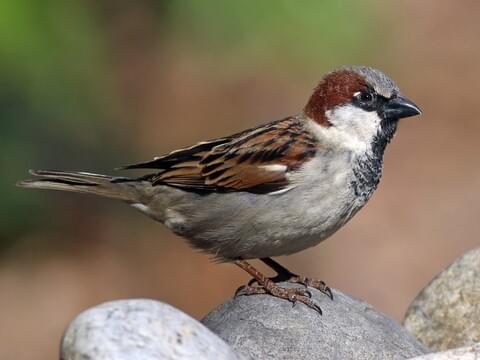
About Pigeon Patrol:
Pigeon Patrol Products & Services is the leading manufacturer and distributor of bird deterrent (control) products in Canada. Pigeon Patrol products have solved pest bird problems in industrial, commercial, and residential settings since 2000, by using safe and humane bird deterrents with only bird and animal friendly solutions. At Pigeon Patrol, we manufacture and offer a variety of bird deterrents, ranging from Ultra-flex Bird Spikes with UV protection, Bird Netting, 4-S Gel and the best Ultrasonic and audible sound devices on the market today.
Contact us at 1- 877– 4– NO-BIRD, (604) 585-9279 or visit our website at www.pigeonpatrol.ca
Bird Gone, Pigeon Gone, Seagull Gone, Pigeon problems, pigeon spikes, 1-877-4NO-BIRD, 4-S Gel, Bird Control, Pigeon Control, bird repellent, Bird Spikes, bird law sonic bird repellent, stainless steel bird spikes, bird spikes Vancouver, Ultra Sonic Bird Control, Bird Netting, Plastic Bird Spikes, Canada bird spike deterrents, Pigeon Pests, B Gone Pigeon, Pigeon Patrol, pest controller, pest control operator, Bird law pest control technician, Pigeon Control Products, humane pigeon spikes, pigeon deterrents, pigeon traps, Pigeon repellents, Sound & Laser Deterrents, wildlife control, raccoon, skunk, squirrel deterrent, De-Fence Spikes, Dragons Den, Canada bird spikes, Canada pigeon, pigeon control, pigeon patrol, pigeon. Kill pigeons, crow, starling, Pigeon Habitat,
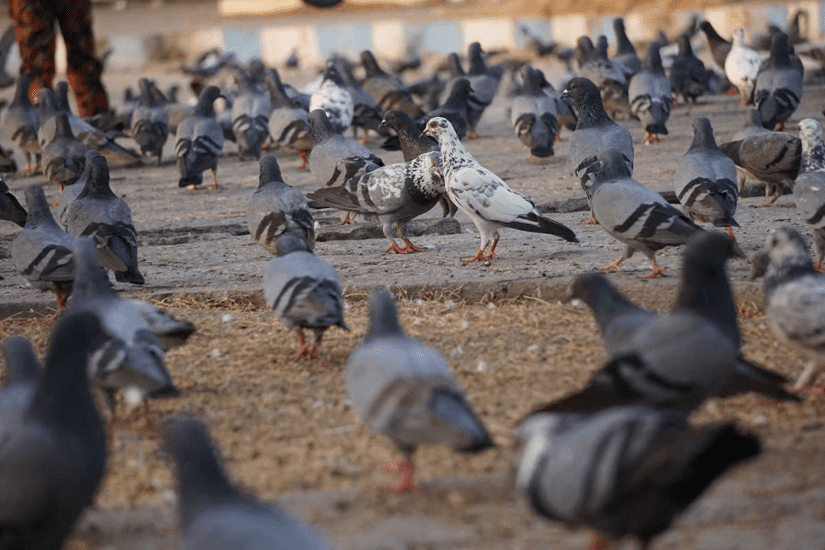
by Pigeon Patrol | Jun 29, 2020 | 4-S Gel Bird repellent, Animal Deterrent Products, Bird Deterrent Products, Bird Netting, Bird Spike, Bird Spikes, Pigeon Control, Pigeon Droppings, Pigeon Patrol's Services, Pigeon Spikes, Pigeons in the News, UltraSonic Bird Control
Pigeon Habitat. Pigeons prefer grains for food and people will commonly feed pigeons unintentionally by spilling food or it in open trash containers. Pigeons roost in areas above ground and will readily nest in steeples, as well as voids on outside areas of buildings and other protected areas.
Pigeons are dependent on humans to provide them with food, roosting and nesting sites. They are commonly found around agricultural areas as well as warehouses, feed mills, and grain elevators. They are also commonly found in cities around parks, buildings, bridges, and any other structures.
Source
About Pigeon Patrol:
Pigeon Patrol Products & Services is the leading manufacturer and distributor of bird deterrent (control) products in Canada. Pigeon Patrol products have solved pest bird problems in industrial, commercial, and residential settings since 2000, by using safe and humane bird deterrents with only bird and animal friendly solutions. At Pigeon Patrol, we manufacture and offer a variety of bird deterrents, ranging from Ultra-flex Bird Spikes with UV protection, Bird Netting, 4-S Gel and the best Ultrasonic and audible sound devices on the market today.
Contact us at 1- 877– 4– NO-BIRD, (604) 585-9279 or visit our website at www.pigeonpatrol.ca
Bird Gone, Pigeon Gone, Seagull Gone, Pigeon problems, pigeon spikes, 1-877-4NO-BIRD, 4-S Gel, Bird Control, Pigeon Control, bird repellent, Bird Spikes, sonic bird repellent, stainless steel bird spikes, bird spikes Vancouver, Ultra Sonic Bird Control, Bird Netting, Plastic Bird Spikes, Canada bird spike deterrents, Pigeon Pests, B Gone Pigeon, Pigeon Patrol, pest controller, pest control operator, pest control technician, Pigeon Control Products, humane pigeon spikes, pigeon deterrents, pigeon traps, Pigeon repellents, Sound & Laser Deterrents, wildlife control, raccoon, skunk, squirrel deterrent, De-Fence Spikes, Dragons Den, Canada bird spikes, Canada pigeon, pigeon control, pidgon patrol, pigeon. Kill pigeons, crow, starling, Pigeon Habitat
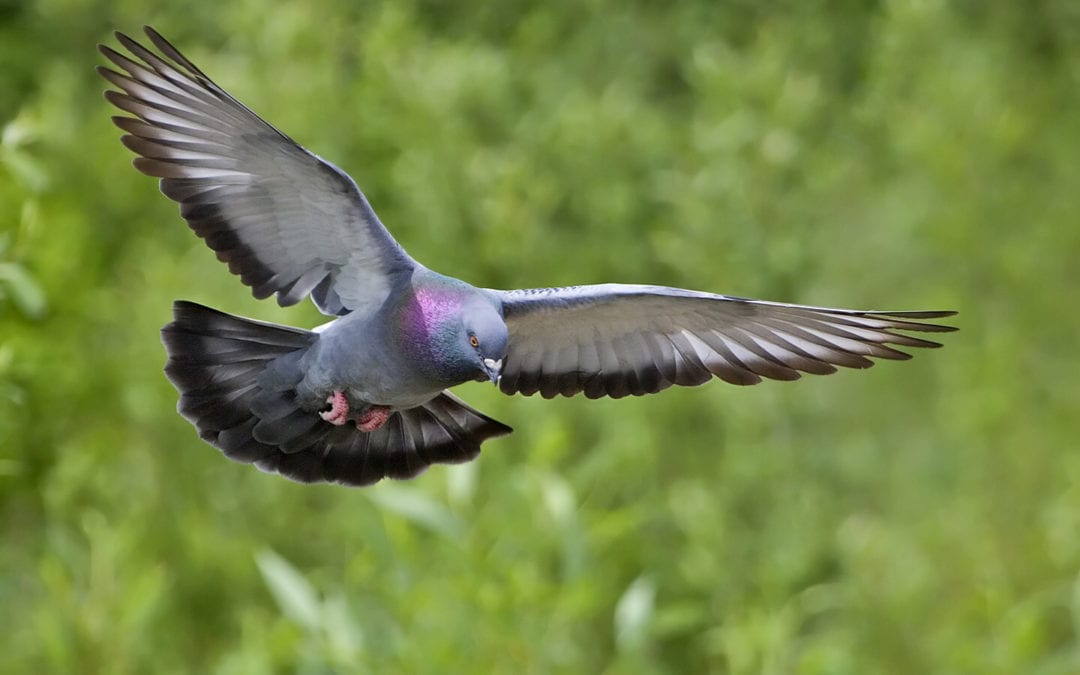
by Pigeon Patrol | Jun 29, 2020 | 4-S Gel Bird repellent, Animal Deterrent Products, Bird Deterrent Products, Bird Netting, Bird Spike, Bird Spikes, Pigeon Control, Pigeon Droppings, Pigeon Patrol's Services, Pigeon Spikes, Pigeons in the News, UltraSonic Bird Control
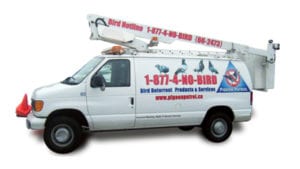 Pigeon Threats? Pigeons are filthy birds, causing disease and damage. Their droppings are known for triggering human slips and falls, as well as accelerating the aging of structures and statues. This makes it imperative to get rid of pigeons in highly trafficked areas. More seriously, pigeons may carry diseases such as cryptococcosis, toxoplasmosis, salmonella, food poisoning, and more. Also, their droppings may harbor the growth of fungus, which causes histoplasmosis. Other pests may live on these birds, including fleas, lice, mites, ticks, and other pests. Pests may also infest nests such as stored product pests.
Pigeon Threats? Pigeons are filthy birds, causing disease and damage. Their droppings are known for triggering human slips and falls, as well as accelerating the aging of structures and statues. This makes it imperative to get rid of pigeons in highly trafficked areas. More seriously, pigeons may carry diseases such as cryptococcosis, toxoplasmosis, salmonella, food poisoning, and more. Also, their droppings may harbor the growth of fungus, which causes histoplasmosis. Other pests may live on these birds, including fleas, lice, mites, ticks, and other pests. Pests may also infest nests such as stored product pests.
If you discover pigeons roosting on your property, contact a professional immediately to discuss a proper course of pigeon control.
Source
About Pigeon Patrol:
Pigeon Patrol Products & Services is the leading manufacturer and distributor of bird deterrent (control) products in Canada. Pigeon Patrol products have solved pest bird problems in industrial, commercial, and residential settings since 2000, by using safe and humane bird deterrents with only bird and animal friendly solutions. At Pigeon Patrol, we manufacture and offer a variety of bird deterrents, ranging from Ultra-flex Bird Spikes with UV protection, Bird Netting, 4-S Gel and the best Ultrasonic and audible sound devices on the market today.
Contact us at 1- 877– 4– NO-BIRD, (604) 585-9279 or visit our website at www.pigeonpatrol.ca
Bird Gone, Pigeon Gone, Seagull Gone, Pigeon problems, pigeon spikes, 1-877-4NO-BIRD, 4-S Gel, Bird Control, Pigeon Control, bird repellent, Bird Spikes, sonic bird repellent, stainless steel bird spikes, bird spikes Vancouver, Ultra Sonic Bird Control, Bird Netting, Plastic Bird Spikes, Canada bird spike deterrents, Pigeon Pests, B Gone Pigeon, Pigeon Patrol, pest controller, pest control operator, pest control technician, Pigeon Control Products, humane pigeon spikes, pigeon deterrents, pigeon traps, Pigeon repellents, Sound & Laser Deterrents, wildlife control, raccoon, skunk, squirrel deterrent, De-Fence Spikes, Dragons Den, Canada bird spikes, Canada pigeon, pigeon control, pidgon patrol, pidgon. Kill pigeons, crow, starling, Pigeon Threats
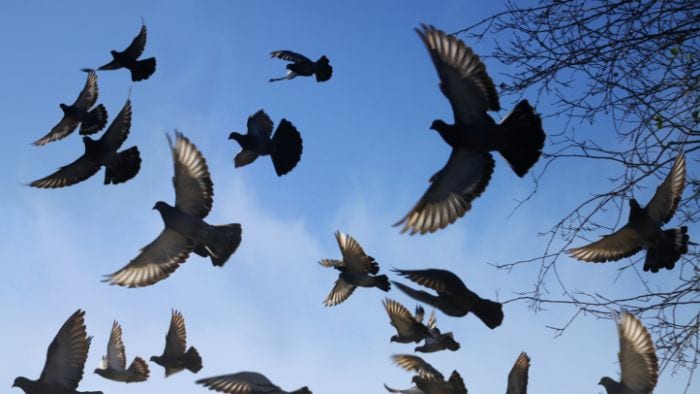
by Pigeon Patrol | Jun 29, 2020 | 4-S Gel Bird repellent, Animal Deterrent Products, Bird Deterrent Products, Bird Netting, Bird Spike, Bird Spikes, Pigeon Control, Pigeon Droppings, Pigeon Patrol's Services, Pigeon Spikes, Pigeons in the News, UltraSonic Bird Control
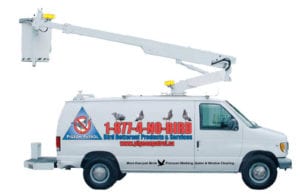 Physical control
Physical control
How can I get rid of pigeons? Controlling pigeons permanently is hard because these birds have adapted to stress, and there are many sources of food available in urban areas. The best way to control them is to change their environment:
- Remove roosting niches and seal any crevices, large openings, and entrances in high areas to discourage pigeons.
- Screen off water sources (like rooftop air conditioners) that pigeons might drink from.
- Never leave food out where pigeons can get it.
- Keep garbage containers closed. Dispose of garbage on a regular basis.
- On flat roofs or ledges, use bristling wires, also known as porcupine wires, or sticky pastes that will discourage pigeons from landing and gathering.
Bird scaring devices
Bird scaring devices can also be bought to frighten birds away from a given area. Loud noises, flashing lights, windmills, and recordings of bird distress calls can be effective ways of controlling pigeons, but may not all be practical in urban settings. Also, pigeons can eventually get used to these types of devices and may ignore them.
If pigeons are a nuisance on a balcony, fine netting can be hung across the front of the balcony, or a combination of visual frightening devices can be used, if they can be moved around to prevent birds from getting used to them.
Source
About Pigeon Patrol:
Pigeon Patrol Products & Services is the leading manufacturer and distributor of bird deterrent (control) products in Canada. Pigeon Patrol products have solved pest bird problems in industrial, commercial, and residential settings since 2000, by using safe and humane bird deterrents with only bird and animal friendly solutions. At Pigeon Patrol, we manufacture and offer a variety of bird deterrents, ranging from Ultra-flex Bird Spikes with UV protection, Bird Netting, 4-S Gel and the best Ultrasonic and audible sound devices on the market today.
Contact us at 1- 877– 4– NO-BIRD, (604) 585-9279 or visit our website at www.pigeonpatrol.ca
Bird Gone, Pigeon Gone, Seagull Gone, Pigeon problems, pigeon spikes, 1-877-4NO-BIRD, 4-S Gel, Bird Control, Pigeon Control, bird repellent, Bird Spikes, sonic bird repellent, stainless steel bird spikes, bird spikes Vancouver, Ultra Sonic Bird Control, Bird Netting, Plastic Bird Spikes, Canada bird spike deterrents, Pigeon Pests, B Gone Pigeon, Pigeon Patrol, pest controller, pest control operator, pest control technician, Pigeon Control Products, humane pigeon spikes, pigeon deterrents, pigeon traps, Pigeon repellents, Sound & Laser Deterrents, wildlife control, raccoon, skunk, squirrel deterrent, De-Fence Spikes, Dragons Den, Canada bird spikes, Canada pigeon, pigeon control, pidgon patrol, pidgon. Kill pigeons, crow, starling, get rid of pigeons
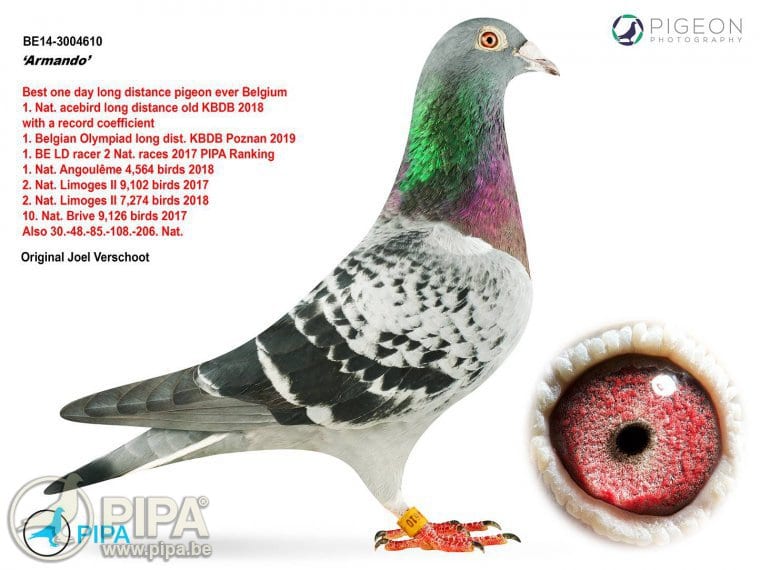
by Pigeon Patrol | Jun 29, 2020 | 4-S Gel Bird repellent, Animal Deterrent Products, Bird Deterrent Products, Bird Netting, Bird Spike, Bird Spikes, Pigeon Control, Pigeon Droppings, Pigeon Patrol's Services, Pigeon Spikes, Pigeons in the News, UltraSonic Bird Control
Should I be concerned of pigeons? Pigeons tend to breed and roost in groups. The biggest problem they cause is the amount of feces (droppings) they produce. The build-up of pigeon feces on buildings and other structures is visually unappealing and is made worse by the fact that pigeon droppings are acidic and erode metal and stonework.
More importantly, pigeon droppings may pose a health hazard to the general public. Pigeons have been associated with a variety of diseases, including histoplasmosis and cryptococcosis.
Histoplasmosis is a disease caused by a fungus that grows in pigeon droppings. The fungus can also be found in bat droppings or in the soil, and is carried by the wind. When removing droppings, people may breathe in some of the fungus. When exposure is high, the fungus can cause infection.
Symptoms of histoplasmosis begin to appear about 10 days after initial infection and can include fatigue, fever, and chest pains. Most infections have no symptoms or appear as a mild respiratory illness. People with weakened immune systems (like cancer patients or people living with HIV/AIDS) are generally more at risk of developing histoplasmosis. The disease cannot be transmitted from person to person.
Cryptococcosis is another fungal disease related to pigeon droppings and grows in soils throughout the world. It is very unlikely that healthy people will become infected even at high levels of exposure. A major risk factor for infection is a compromised immune system.
Source
About Pigeon Patrol:
Pigeon Patrol Products & Services is the leading manufacturer and distributor of bird deterrent (control) products in Canada. Pigeon Patrol products have solved pest bird problems in industrial, commercial, and residential settings since 2000, by using safe and humane bird deterrents with only bird and animal friendly solutions. At Pigeon Patrol, we manufacture and offer a variety of bird deterrents, ranging from Ultra-flex Bird Spikes with UV protection, Bird Netting, 4-S Gel and the best Ultrasonic and audible sound devices on the market today.
Contact us at 1- 877– 4– NO-BIRD, (604) 585-9279 or visit our website at www.pigeonpatrol.ca
Bird Gone, Pigeon Gone, Seagull Gone, Pigeon problems, pigeon spikes, 1-877-4NO-BIRD, 4-S Gel, Bird Control, Pigeon Control, bird repellent, Bird Spikes, sonic bird repellent, stainless steel bird spikes, bird spikes Vancouver, Ultra Sonic Bird Control, Bird Netting, Plastic Bird Spikes, Canada bird spike deterrents, Pigeon Pests, B Gone Pigeon, Pigeon Patrol, pest controller, pest control operator, pest control technician, Pigeon Control Products, humane pigeon spikes, pigeon deterrents, pigeon traps, Pigeon repellents, Sound & Laser Deterrents, wildlife control, raccoon, skunk, squirrel deterrent, De-Fence Spikes, Dragons Den, Canada bird spikes, Canada pigeon, pigeon control, pidgon patrol, pidgon. Kill pigeons, crow, starling, concerned of pigeons
by Pigeon Patrol | Jun 29, 2020 | 4-S Gel Bird repellent, Animal Deterrent Products, Bird Deterrent Products, Bird Netting, Bird Spike, Bird Spikes, Pigeon Control, Pigeon Droppings, Pigeon Patrol's Services, Pigeon Spikes, Pigeons in the News, UltraSonic Bird Control
What are Pigeons? Pigeons are stout-bodied birds with short necks and short, slender bills with a fleshy cere (the waxy, fleshy covering at the base of the upper beak). The species most commonly referred to just as the “pigeon” is the feral rock pigeon, common in many cities and small rural areas.
The rock pigeon is 32 to 37 cm (12.5 to 14.5 inches) long with a 64 to 72 cm (25 to 28 inch) wingspan. Its lower back is white with two distinctive black bars on its pale grey wings. Its tail has white markings. It is a strong and quick flier, with its lighter grey rump easily seen from above.
The head and neck of the mature pigeon are a darker blue-grey than the back and wings. The green and lilac or purple patch on the side of the neck is larger than that of the stock dove, and the tail is more distinctly banded.
Pigeons come in many different colours depending on age: dark grey, light blue/grey, brown, peach, grey and white, pure white, and more. The feathers of young birds show little lustre and are duller. The eye colour of a pigeon is generally orange, but a few pigeons may have white-grey eyes. The eyelids are orange and are enclosed in a grey-white eye ring. The feet are red to pink.
Source
About Pigeon Patrol:
Pigeon Patrol Products & Services is the leading manufacturer and distributor of bird deterrent (control) products in Canada. Pigeon Patrol products have solved pest bird problems in industrial, commercial, and residential settings since 2000, by using safe and humane bird deterrents with only bird and animal friendly solutions. At Pigeon Patrol, we manufacture and offer a variety of bird deterrents, ranging from Ultra-flex Bird Spikes with UV protection, Bird Netting, 4-S Gel and the best Ultrasonic and audible sound devices on the market today.
Contact us at 1- 877– 4– NO-BIRD, (604) 585-9279 or visit our website at www.pigeonpatrol.ca
Bird Gone, Pigeon Gone, Seagull Gone, Pigeon problems, pigeon spikes, 1-877-4NO-BIRD, 4-S Gel, Bird Control, Pigeon Control, bird repellent, Bird Spikes, sonic bird repellent, stainless steel bird spikes, bird spikes Vancouver, Ultra Sonic Bird Control, Bird Netting, Plastic Bird Spikes, Canada bird spike deterrents, Pigeon Pests, B Gone Pigeon, Pigeon Patrol, pest controller, pest control operator, pest control technician, Pigeon Control Products, humane pigeon spikes, pigeon deterrents, pigeon traps, Pigeon repellents, Sound & Laser Deterrents, wildlife control, raccoon, skunk, squirrel deterrent, De-Fence Spikes, Dragons Den, Canada bird spikes, Canada pigeon, pigeon control, pidgon patrol, pidgon. Kill pigeons, crow, starling
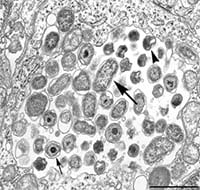
by Pigeon Patrol | Jun 29, 2020 | 4-S Gel Bird repellent, Animal Deterrent Products, Bird Deterrent Products, Bird Netting, Bird Spike, Bird Spikes, Pigeon Control, Pigeon Droppings, Pigeon Patrol's Services, Pigeon Spikes, Pigeons in the News, UltraSonic Bird Control
 Pigeon droppings and public health, Disease risk from pigeon droppings is often used to justify killing pigeons, but fresh bird droppings have not been shown to present a health risk.
Pigeon droppings and public health, Disease risk from pigeon droppings is often used to justify killing pigeons, but fresh bird droppings have not been shown to present a health risk.
People may fear that pigeons roosting or nesting nearby, or more specifically the droppings that accompany such sites, are a health threat. These fears usually focus on histoplasmosis, a fungus that grows in dropping-enriched soil, and on diseases caused by Cryptococcus and Salmonella. However, there is little evidence linking pigeons directly to human infections.
Histoplasmosis fungus is common in the eastern and central U.S. As many as 80 percent of people tested in these areas prove to have already been exposed to the fungus without knowing.
According to the Centers for Disease Control, fresh bird droppings on surfaces such as sidewalks and windowsills have not been shown to present a health risk. People should avoid contact with any animal droppings, of course, and ordinary good hygiene, such as washing hands and leaving shoes at the door, are adequate prevention if you accidentally come into contact with animal droppings.
About Pigeon Patrol:
Pigeon Patrol Products & Services is the leading manufacturer and distributor of bird deterrent (control) products in Canada. Pigeon Patrol products have solved pest bird problems in industrial, commercial, and residential settings since 2000, by using safe and humane bird deterrents with only bird and animal friendly solutions. At Pigeon Patrol, we manufacture and offer a variety of bird deterrents, ranging from Ultra-flex Bird Spikes with UV protection, Bird Netting, 4-S Gel and the best Ultrasonic and audible sound devices on the market today.
Contact us at 1- 877– 4– NO-BIRD, (604) 585-9279 or visit our website at www.pigeonpatrol.ca
Pigeon droppings and public health, Bird Gone, Pigeon Gone, Seagull Gone, Pigeon problems, pigeon spikes, 1-877-4NO-BIRD, 4-S Gel, Bird Control, Pigeon Control, bird repellent, Bird Spikes, sonic bird repellent, stainless steel bird spikes, bird spikes Vancouver, Ultra Sonic Bird Control, Bird Netting, Plastic Bird Spikes, Canada bird spike deterrents, Pigeon Pests, B Gone Pigeon, Pigeon Patrol, pest controller, pest control operator, pest control technician, Pigeon Control Products, humane pigeon spikes, pigeon deterrents, pigeon traps, Pigeon repellents, Sound & Laser Deterrents, wildlife control, raccoon, skunk, squirrel deterrent, De-Fence Spikes, Dragons Den, Canada bird spikes, Canada pigeon, pigeon control, pidgon patrol, pidgon. Kill pigeons, crow, starling

by Pigeon Patrol | Jun 29, 2020 | 4-S Gel Bird repellent, Animal Deterrent Products, Bird Deterrent Products, Bird Netting, Bird Spike, Bird Spikes, Pigeon Control, Pigeon Droppings, Pigeon Patrol's Services, Pigeon Spikes, Pigeons in the News, UltraSonic Bird Control
Three steps to humanely solve a pigeon problem
You may just need one or a combination of all three techniques to humanely solve a pigeon problem, depending on the size of the pigeon population you’re dealing with.
Stop feeding the pigeons (intentionally or not)
Most conflicts with pigeons can be tied at one point or another to feeding, intentionally or otherwise.
Pigeons get fed plenty of handouts and garbage, but there are also well-intentioned pigeon lovers who regularly feed the birds. This does the pigeons more harm than good as the pigeons begin to gather in large numbers, often leading to inhumane and ineffective attempts to reduce their numbers.
When such troubles arise, the best thing for the birds is to reduce feeding gradually over several weeks. The flock will gradually disperse until the remaining number of birds matches what the area can naturally support this is the best way to humanely solve a pigeon problem.
.
Unintentional food sources
Even when not feeding on purpose, we humans are messy, leaving leftovers and dropped crumbs everywhere. Pigeons hang around town squares, public parks, and other trafficked areas to help themselves to what we leave behind, especially when convenient roosting and nesting sites are nearby. To discourage pigeons from gathering, food attractants need to be cleaned up regularly.
In suburban neighborhoods, too, homeowners may mistakenly feed pigeons or they may be providing food for pigeons inadvertently when feeding their backyard birds by tossing seed on the ground, rather than putting it in birdfeeders. To discourage pigeons visiting your yard, change the type, amount, and timing of feeding. If most of the pigeons fail to move elsewhere, you’ll need to stop feeding all birds for a couple weeks. (Don’t worry; the birds won’t starve.) When you resume feeding, only put out seed in birdfeeders and keep the ground below them cleaned up.
Prevent roosting and nesting
Pigeons look for flat surfaces for roosting and nesting. Encourage them to do these things elsewhere by making flat surfaces unavailable to them. With the correct application of the right product, roosting structures can be rendered virtually pigeon-free.
There are a variety of devices that can be used to change flat nesting spots into inaccessible spaces and prevent pigeons from roosting in areas where they’re not wanted.
- Attach wood or metal sheathing (Birdslides) at a 45- to 60-degree angle over window ledges and other flat surfaces to keep pigeons from landing.
- Install “bird wires” to keep pigeons off ledges, railings, awnings, and rooftops.
- Use netting to keep pigeons out of large areas.
NEVER use polybutylene gel. Sticky gel repellents made from polybutene can harm all birds and any animal that comes in contact with it. The HSUS strongly recommends that these dangerous repellents be avoided at all costs. The feathers of any bird who comes into contact with the dense, sticky gel will become damaged, interfering with their ability to fly and to stay water-proofed.
These gel repellents are not selective. Other birds are likely to land on the gel, get stuck, and die a slow death. The polybutene gels are particularly harmful to smaller species.
Limit flock size with pigeon birth control
As year-round nesters, a pair of pigeons can raise a dozen or more young each year. If pigeons have plenty of food and space, their numbers can quickly increase. Fortunately, a bird contraceptive is available that limits growth of pigeon flocks.
Ovocontrol bird food is “birth control” for pigeons. Innolytics, LLC
Known as OvoControl, pigeon contraception comes in the form of a kibble-type food, which causes birds who eat it regularly to lay eggs that fail to develop. In March 2010, OvoControl received landmark general-use approval by the Environmental Protection Agency. Visit ovocontrol.com to learn more about the product and how you can implement an OvoControl program.
Combined with exclusion and other humane measures to discourage roosting and nesting, OvoControl effectively reduces hatching rates in pigeons, thereby limiting flock sizes and diminishing problems associated with large numbers of pigeons.
Business owners who pledge to use OvoControl instead of lethal methods can download our free signage and educational materials. In Hawaii, where pigeons can be a major problem, businesses that have started OvoControl programs have seen a noticeable decrease in pigeon numbers.
Source
About Pigeon Patrol:
Pigeon Patrol Products & Services is the leading manufacturer and distributor of bird deterrent (control) products in Canada. Pigeon Patrol products have solved pest bird problems in industrial, commercial, and residential settings since 2000, by using safe and humane bird deterrents with only bird and animal friendly solutions. At Pigeon Patrol, we manufacture and offer a variety of bird deterrents, ranging from Ultra-flex Bird Spikes with UV protection, Bird Netting, 4-S Gel and the best Ultrasonic and audible sound devices on the market today.
Contact us at 1- 877– 4– NO-BIRD, (604) 585-9279 or visit our website at www.pigeonpatrol.ca
Bird Gone, Pigeon Gone, Seagull Gone, Pigeon problems, pigeon spikes, 1-877-4NO-BIRD, 4-S Gel, Bird Control, Pigeon Control, bird repellent, Bird Spikes, sonic bird repellent, stainless steel bird spikes, bird spikes Vancouver, Ultra Sonic Bird Control, Bird Netting, Plastic Bird Spikes, Canada bird spike deterrents, Pigeon Pests, B Gone Pigeon, Pigeon Patrol, pest controller, pest control operator, pest control technician, Pigeon Control Products, humane pigeon spikes, pigeon deterrents, pigeon traps, Pigeon repellents, Sound & Laser Deterrents, wildlife control, raccoon, skunk, squirrel deterrent, De-Fence Spikes, Dragons Den, Canada bird spikes, Canada pigeon, pigeon control, pidgon patrol, pidgon. Kill pigeons, crow, starling
by Pigeon Patrol | Jun 29, 2020 | 4-S Gel Bird repellent, Animal Deterrent Products, Bird Deterrent Products, Bird Netting, Bird Spike, Bird Spikes, Pigeon Control, Pigeon Droppings, Pigeon Patrol's Services, Pigeon Spikes, Pigeons in the News, UltraSonic Bird Control
How to protect your home or business from European Starlings? A build-up of bird numbers in urban environments is normally a result of the presence of a readily accessible food supply and/or the availability of attractive habitats where they can roost or breed. Effective long-term management is normally dependent on the ability to eliminate or reduce these aspects.
Birds can be prevented from entering or roosting on buildings by either installing netting over vulnerable areas or fixing wire, plastic or other purpose-designed devices to deter birds from landing on ledges, window sills or other structures. It is also helpful to seal up all cracks and crevices on structures with sealant. Vent openings for dryer, stove and bathroom fans are a common nesting site for starlings during spring and summer.
The fitting of proofing and deterrent measures can be complicated, and should be done by professionals.
As is the case with most wildlife issues, prevention is a much easier solution as opposed to tackling the problem after a full blown infestation. Using preventive measures to make sure starlings do not make their nest on your home or business is much easier and more cost effective than having to deal with structural damage and the mess from starling droppings or even legal liability if someone slips on bird droppings outside your business.
Source
About Pigeon Patrol:
Pigeon Patrol Products & Services is the leading manufacturer and distributor of bird deterrent (control) products in Canada. Pigeon Patrol products have solved pest bird problems in industrial, commercial, and residential settings since 2000, by using safe and humane bird deterrents with only bird and animal friendly solutions. At Pigeon Patrol, we manufacture and offer a variety of bird deterrents, ranging from Ultra-flex Bird Spikes with UV protection, Bird Netting, 4-S Gel and the best Ultrasonic and audible sound devices on the market today.
Contact us at 1- 877– 4– NO-BIRD, (604) 585-9279 or visit our website at www.pigeonpatrol.ca
Bird Gone, Pigeon Gone, Seagull Gone, Pigeon problems, pigeon spikes, 1-877-4NO-BIRD, 4-S Gel, Bird Control, Pigeon Control, bird repellent, Bird Spikes, sonic bird repellent, stainless steel bird spikes, bird spikes Vancouver, Ultra Sonic Bird Control, Bird Netting, Plastic Bird Spikes, Canada bird spike deterrents, Pigeon Pests, B Gone Pigeon, Pigeon Patrol, pest controller, pest control operator, pest control technician, Pigeon Control Products, humane pigeon spikes, pigeon deterrents, European Starlings, pigeon traps, Pigeon repellents, Sound & Laser Deterrents, wildlife control, raccoon, skunk, squirrel deterrent, De-Fence Spikes, Dragons Den, Canada bird spikes, Canada pigeon, pigeon control, pidgon patrol, pidgon. Kill pigeons, crow, starling

by Pigeon Patrol | Jun 29, 2020 | 4-S Gel Bird repellent, Animal Deterrent Products, Bird Deterrent Products, Bird Netting, Bird Spike, Bird Spikes, Pigeon Control, Pigeon Droppings, Pigeon Patrol's Services, Pigeon Spikes, Pigeons in the News, UltraSonic Bird Control
 Starlings create problems for livestock and poultry facilities, causing hundreds of millions of dollars in damage to agricultural operations yearly. Starlings gather at feed troughs to eat, contaminating food and water sources in the process. Starlings are also known to enter buildings to roost and build nests, creating sanitation problems.
Starlings create problems for livestock and poultry facilities, causing hundreds of millions of dollars in damage to agricultural operations yearly. Starlings gather at feed troughs to eat, contaminating food and water sources in the process. Starlings are also known to enter buildings to roost and build nests, creating sanitation problems.
European Starlings can carry diseases that are transmissible to livestock and to people, including TGE (transmissible gastroenteritis – a disease of swine), blastomycosis, and salmonella.
Sanitation issues involving starlings are another problem. In cities, large amounts of droppings can make streets dangerously slippery and can be corrosive to cars, buildings, and statues. The sheer amount of droppings together with their chemical action can damage and kill trees and any vegetation underneath.
Starlings travel in flocks of thousands and pose an incredible hazard to air travel. They often forage near airports and have been implicated in air disasters, particularly when planes have collided with entire flocks of birds.
It is not uncommon for a flock of 4000 Starlings to cause major loss of revenue in a large vineyard in a week’s time. Starlings are also capable of destroying blueberries, cherries, other types of pitted fruit, and even apples.
European Starlings also have detrimental effects on native ecosystems, particularly through their tendency to out compete native bird species for food and nest sites. European Starlings are cavity nesters and are known to compete with woodpeckers, Great Crested Flycatchers, Tree Swallows, Eastern Bluebirds and Purple Martins for nests, possibly causing these populations to decline. They also carry diseases, ticks and mites that are spread to native bird species and even humans.
Source
About Pigeon Patrol:
Pigeon Patrol Products & Services is the leading manufacturer and distributor of bird deterrent (control) products in Canada. Pigeon Patrol products have solved pest bird problems in industrial, commercial, and residential settings since 2000, by using safe and humane bird deterrents with only bird and animal friendly solutions. At Pigeon Patrol, we manufacture and offer a variety of bird deterrents, ranging from Ultra-flex Bird Spikes with UV protection, Bird Netting, 4-S Gel and the best Ultrasonic and audible sound devices on the market today.
Contact us at 1- 877– 4– NO-BIRD, (604) 585-9279 or visit our website at www.pigeonpatrol.ca
Bird Gone, Pigeon Gone, Seagull Gone, Pigeon problems, pigeon spikes, 1-877-4NO-BIRD, 4-S Gel, Bird Control, Pigeon Control, bird repellent, Bird Spikes, sonic bird repellent, stainless steel bird spikes, bird spikes Vancouver, Ultra Sonic Bird Control, Bird Netting, Plastic Bird Spikes, Canada bird spike deterrents, Pigeon Pests, B Gone Pigeon, Pigeon Patrol, pest controller, pest control operator, pest control technician, Pigeon Control Products, humane pigeon spikes, pigeon deterrents, pigeon traps, Pigeon repellents, Sound & Laser Deterrents, wildlife control, raccoon, skunk, squirrel deterrent, De-Fence Spikes, Dragons Den, Canada bird spikes, Canada pigeon, pigeon control, pidgon patrol, pidgon. Kill pigeons, crow, starling
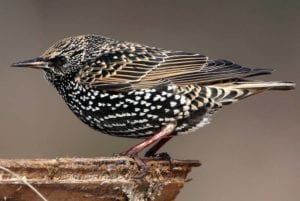
by Pigeon Patrol | Jun 29, 2020 | 4-S Gel Bird repellent, Animal Deterrent Products, Bird Deterrent Products, Bird Netting, Bird Spike, Bird Spikes, Pigeon Control, Pigeon Droppings, Pigeon Patrol's Services, Pigeon Spikes, Pigeons in the News, UltraSonic Bird Control
How did starling populations become so large? European Starlings were first introduced to the United States in 1890. Rumour has it that sixty to one hundred starlings were released in Central Park in hopes that all of the birds mentioned in

Shakespeare’s works would become established in the New World. In the case of the starling, the wish became reality. In the intervening hundred years the starling population has grown to an estimated 150-200 million birds.
Starlings thrived because they are able to exploit a large variety of habitats, nest sites and food sources. They will eat almost anything, including a diverse variety of invertebrates, fruits, and seeds.
Source
About Pigeon Patrol:
Pigeon Patrol Products & Services is the leading manufacturer and distributor of bird deterrent (control) products in Canada. Pigeon Patrol products have solved pest bird problems in industrial, commercial, and residential settings since 2000, by using safe and humane bird deterrents with only bird and animal friendly solutions. At Pigeon Patrol, we manufacture and offer a variety of bird deterrents, ranging from Ultra-flex Bird Spikes with UV protection, Bird Netting, 4-S Gel and the best Ultrasonic and audible sound devices on the market today.
Contact us at 1- 877– 4– NO-BIRD, (604) 585-9279 or visit our website at www.pigeonpatrol.ca
Bird Gone, Pigeon Gone, Seagull Gone, Pigeon problems, pigeon spikes, 1-877-4NO-BIRD, 4-S Gel, Bird Control, Pigeon Control, bird repellent, Bird Spikes, sonic bird repellent, stainless steel bird spikes, bird spikes Vancouver, Ultra Sonic Bird Control, Bird Netting, Plastic Bird Spikes, Canada bird spike deterrents, Pigeon Pests, B Gone Pigeon, Pigeon Patrol, pest controller, pest control operator, pest control technician, Pigeon Control Products, humane pigeon spikes, pigeon deterrents, pigeon traps, Pigeon repellents, Sound & Laser Deterrents, wildlife control, raccoon, skunk, squirrel deterrent, De-Fence Spikes, Dragons Den, Canada bird spikes, Canada pigeon, pigeon control, pidgon patrol, pidgon. Kill pigeons, crow, starling

by Pigeon Patrol | May 27, 2020 | 4-S Gel Bird repellent, Animal Deterrent Products, Bird Deterrent Products, Bird Netting, Bird Spike, Bird Spikes, Pigeon Control, Pigeon Droppings, Pigeon Patrol's Services, Pigeon Spikes, Pigeons in the News, UltraSonic Bird Control
In the long run, we can best deal with any problems house sparrows cause us through the habitat we control. For instance, prompt trash cleanup using bird-proof trash containers goes a long way to limit house sparrow activity around outdoor eateries, picnic spots and dumpsters.
Nesting in building crevices and vents
Nesting sparrows can be very noisy. And house sparrows strongly prefer to nest in, on, or near our buildings. The noise can be annoying, especially because they start singing at the very first light. But their habit of packing nesting material in stove, dryer and fan vents may prevents use of the vents—a more serious problem.
Excluding house sparrows from places we don’t want nests before they build is the first—and best—approach. Install covers over vents and check screening over louvers before birds find their way inside.
Building crevices
If the birds have already started to move in, the basic steps are simple. See where birds are nesting, wait until there are no young present, remove nesting material, and block openings with netting, hardware cloth, or other appropriate materials.
If you find eggs or young birds in building crevice nests, leave the nesters to their task. The young hatch at different times and leave over a staggered period. So, you may have to wait 2 to 4 weeks. Check the nest frequently. When the young leave, as swiftly as possible, remove nest material and exclude the birds before they can start a second nest.
Dryer and stove vents
These can be slightly more complicated. Vents with nests inside may not function properly. This can be inconvenient or, in some cases, unsafe. The nesting material may need to be removed immediately.
Birds using vents make noise that the vent itself tends to amplify. Act right away if you hear scratching and shuffling. If eggs or young are already in the nest, can this vent be left unused until they fledge? If so, treat this nest like a nest in a building crevice.
If young are present in the vent and there is no option to leave them there until they fledge, the parents can still raise their young in an alternate nest.
- Make a substitute nest from a wicker basket, a plastic gallon jug, or a small birdhouse.
- Cut an U shape opening in the plastic jug and flip the “door” up to keep rain out.
- Attach the substitute nest as close as possible to the original nest, but in as much shade as possible.
- Carefully remove nesting material and nestlings, and place in substitute nest.
Noisy nestlings usually attract the parents who will continue to care for them. Watch the substitute nest to see that the adults return. They should not take more than a half hour or so, as growing young birds need constant feeding. If the adults do not return to nestlings, contact a wildlife rehabilitator in your area for advice. This procedure won’t work with eggs, and you can remove house sparrow eggs when cleaning nest material out of ducts. However, we recommend leaving them to complete the cycle for this one nesting period, and bear in mind that virtually all birds but starlings and house sparrows are protected by federal law, and to remove their nests or eggs would be illegal.
Finally and importantly, promptly install a vent cover to keep other sparrows, and other birds, out.
About Pigeon Patrol:
Pigeon Patrol Products & Services is the leading manufacturer and distributor of bird deterrent (control) products in Canada. Pigeon Patrol products have solved pest bird problems in industrial, commercial, and residential settings since 2000, by using safe and humane bird deterrents with only bird and animal friendly solutions. At Pigeon Patrol, we manufacture and offer a variety of bird deterrents, ranging from Ultra-flex Bird Spikes with UV protection, Bird Netting, 4-S Gel and the best Ultrasonic and audible sound devices on the market today.
Contact us at 1- 877– 4– NO-BIRD, (604) 585-9279 or visit our website at www.pigeonpatrol.ca
Bird Gone, Pigeon Gone, Seagull Gone, Pigeon problems, pigeon spikes, 1-877-4NO-BIRD, 4-S Gel, Bird Control, Pigeon Control, bird repellent, Bird Spikes, sonic bird repellent, stainless steel bird spikes, bird spikes Vancouver, Ultra Sonic Bird Control, Bird Netting, Plastic Bird Spikes, Canada bird spike deterrents, Pigeon Pests, B Gone Pigeon, Pigeon Patrol, pest controller, pest control operator, pest control technician, Pigeon Control Products, humane pigeon spikes, pigeon deterrents, pigeon traps, Pigeon repellents, Sound & Laser Deterrents, wildlife control, raccoon, skunk, squirrel deterrent, De-Fence Spikes, Dragons Den, Canada bird spikes, Canada pigeon, pigeon control, pidgon patrol, pidgon. Kill pigeons, crow, starling


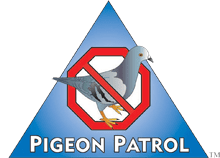











 Examples: Cardinals, robins, goldfinches.
Examples: Cardinals, robins, goldfinches.



















 Pigeon Threats? Pigeons are filthy birds, causing disease and damage. Their droppings are known for triggering human slips and falls, as well as accelerating the aging of structures and statues. This makes it imperative to get rid of pigeons in highly trafficked areas. More seriously, pigeons may carry diseases such as cryptococcosis, toxoplasmosis, salmonella, food poisoning, and more. Also, their droppings may harbor the growth of fungus, which causes histoplasmosis. Other pests may live on these birds, including fleas, lice, mites, ticks, and other pests. Pests may also infest nests such as stored product pests.
Pigeon Threats? Pigeons are filthy birds, causing disease and damage. Their droppings are known for triggering human slips and falls, as well as accelerating the aging of structures and statues. This makes it imperative to get rid of pigeons in highly trafficked areas. More seriously, pigeons may carry diseases such as cryptococcosis, toxoplasmosis, salmonella, food poisoning, and more. Also, their droppings may harbor the growth of fungus, which causes histoplasmosis. Other pests may live on these birds, including fleas, lice, mites, ticks, and other pests. Pests may also infest nests such as stored product pests.
 Physical control
Physical control


